Chapter 14 | Use of Speed Detection Devices and Red Light Cameras¶
CHAPTER 14 Use of Speed Detection Devices and Red Light Cameras¶
- Article 1 General Provisions
- Article 2 Speed Detection Devices
- Article 3 Red Light Cameras

Abner Jay stands at the center of St. Marys, gazing intensely at a red light camera as he vigorously paints its image on a large canvas, capturing every detail with raw emotion and bold strokes, embodying the essence of Lucian Freud's style in an art piece that evokes both contemplation and action.
Article 1 General Provisions {#t40c14a01}

40-14-1.Definitions.¶
As used in this chapter, the term:

-
“Campus” means the grounds owned or occupied by a college or university.

Mirabeau Lamar dramatically gestures towards the sprawling university grounds, surrounded by a captivating display of vintage Black-authored books at For Keeps Bookstore in Atlanta, Georgia. -
“Campus law enforcement agency” means the campus agency charged with the enforcement of the laws of this state.

James Neill, in a silent film style, mimics patrolling the campus with exaggerated tiptoe steps and humorous over-the-shoulder glances while holding an imaginary magnifying glass, near Bobby Jones' grave surrounded by golf balls; all captured in a long-exposure black-and-white photograph reminiscent of Hiroshi Sugimoto's seascapes, highlighting the timeless vigilance of campus law enforcement. -
“College or university” means an accredited public or private educational institution of higher learning.
- “Speed detection device” means, unless otherwise indicated, that particular device designed to measure the speed or velocity of a motor vehicle and marketed under the name “Vascar” or any similar device operating under the same or similar principle and any devices for the measurement of speed or velocity based upon the Doppler principle of radar or the speed timing principle of laser. All such devices must meet or exceed the minimum performance specifications established by the Department of Public Safety.
Article 2 Speed Detection Devices {#t40c14a02}

-
40-14-1.1. Definitions.
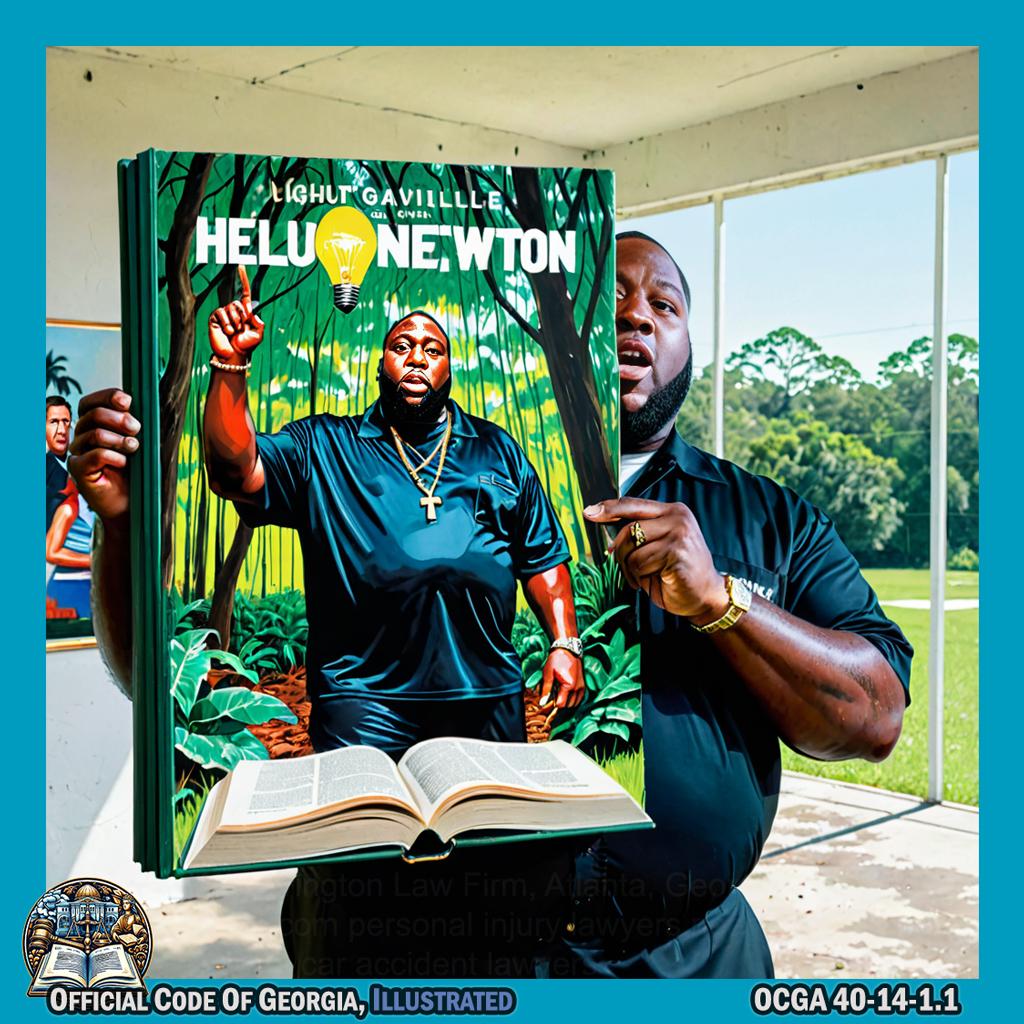
Killer Mike, standing in the lush Georgia setting of Gainesville, opens an imaginary large book, points to a word, scratches his head in confusion before having a lightbulb moment and excitedly jumps up with a finger raised as if he's just understood the definition. -
40-14-1.2. Agent not private investigator or subject to certain laws.
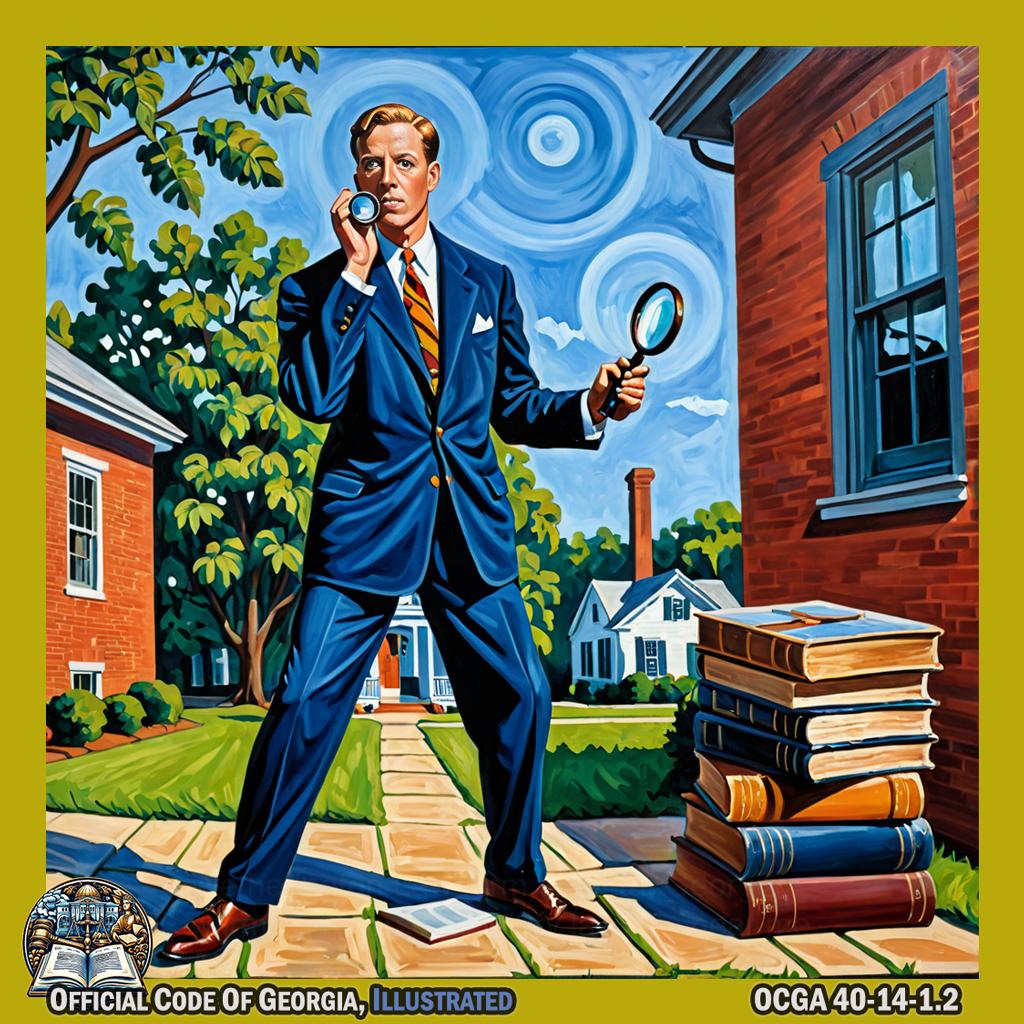
Singer John Berry, born in South Carolina, strikes a secret agent pose while holding a magnifying glass and tiptoeing past a stack of law books in the Colonial Homes neighborhood in Atlanta, Georgia. -@JohnBerryMusic - 40-14-3. Application for permit; use of device while application pending.
- 40-14-4. Compliance with rules of Federal Communications Commission; certification of devices.
- 40-14-5. Testing of radar devices; removal of inaccurate radar devices from service; maintenance of testing log and independent calibration tests of automated traffic enforcement devices.
- 40-14-6. Warning signs required; signage requirements.
- 40-14-7. Visibility of vehicle from which device is operated.
- 40-14-8. When case may be made and conviction had.
- 40-14-9. Certain evidence inadmissible; use of device on hill.
-
40-14-10. Unlawful use of devices generally.

Actor Ken Sagoes, in the style of an art piece by Ashley Bickerton, pretends to be a mad scientist using a giant magnet to disrupt electronic devices in a playful and exaggerated manner. -@KenSagoes - 40-14-12. Administrative hearing upon permit suspension or revocation.
- 40-14-13. Administrative and judicial appeal of decision suspending or revoking permit.
-
40-14-14. Petition for reconsideration following permit suspension or revocation.

Rapper Quando Rondo is seen holding a sign that says "Reconsider Permit" in front of a building with a suspended or revoked permit, set against the rich scene of Waycross, Georgia. -@quando_rondo -
40-14-15. Rehearing or restoration of permit at direction of Governor.
-
40-14-16. Restrictions on suspension or revocation of drivers’ licenses; reports to Department of Driver Services to specify speed.

Florida-born space shuttle pilot Eric A. Boe, depicted in the style of Karl Blossfeldt, performs an artful portrayal of driving a car with one hand on an imaginary steering wheel, the other hand holding a pretend license, and gesturing to slow down while pretending to look at a speed sign. -@Astro_Boe -
40-14-17. Laser devices; reliability and admissibility of evidence.
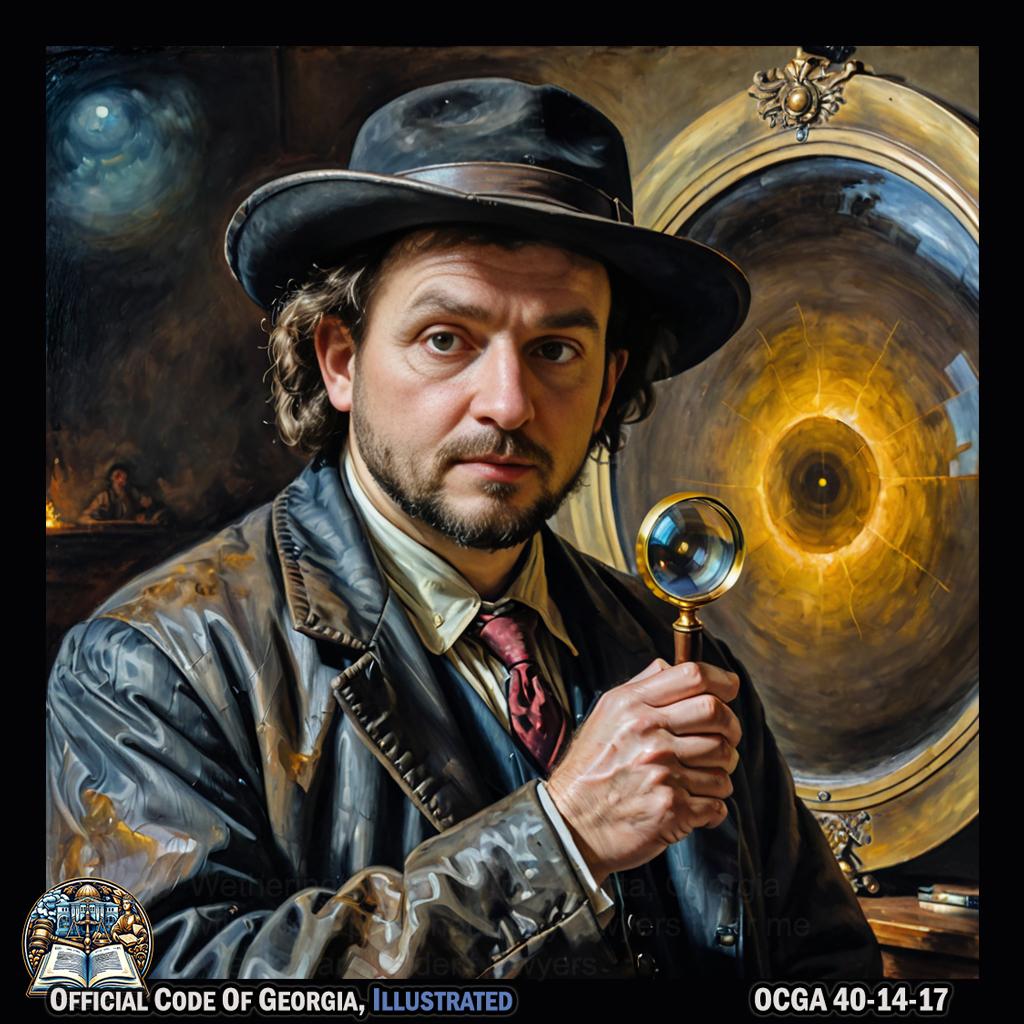
JID, dressed as a detective, intently examines a large magnifying glass and inspects a laser device for evidence in the atmospheric Quinlan Visual Arts Center in Georgia. -@JIDsv -
40-14-18. Enforcement of speed limit in school zones with recorded images; civil monetary penalty; vehicle registration and transfer of title restrictions for failure to pay penalty.
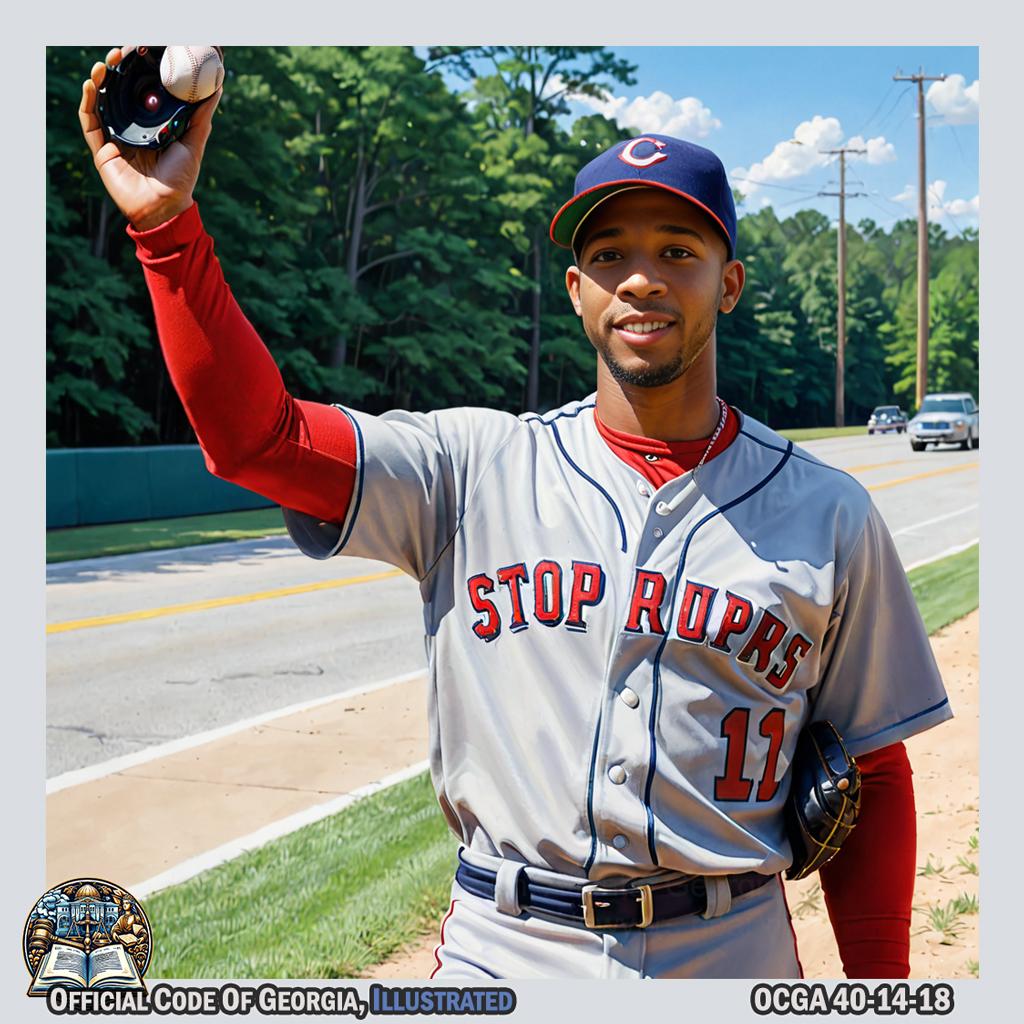
Ben Revere, a baseball player, stood in the picturesque Columbus, Georgia location, holding a toy car and pretending to take a picture with an imaginary camera before making a "stop" motion with his hand and putting a pretend ticket on the car. -@BenRevere9
40-14-1.1.Definitions.¶
As used in this article, the term:

-
“Agent” means a person or entity who is authorized by a law enforcement agency or governing body to administer the procedures contained herein and:
- Provides services to such law enforcement agency or governing body;
- Operates, maintains, leases, or licenses an automated traffic enforcement safety device; or
- Is authorized by such law enforcement agency or governing body to review and assemble the recorded images captured by the automated traffic enforcement safety device for review by a peace officer.
-
“Automated traffic enforcement safety device” means a speed detection device that:

Randy McMichael, in the style of Alberto Giacometti, visually and physically represents an automated traffic enforcement safety device as he elongates his body dramatically to symbolize the speed detection function, with exaggerated arms and legs extending outward in a dynamic and engaging manner within a vibrant South Atlanta neighborhood setting. - Is capable of producing photographically recorded still or video images, or both, of the rear of a motor vehicle or of the rear of a motor vehicle being towed by another vehicle, including an image of such vehicle’s rear license plate;
- Is capable of monitoring the speed of a vehicle as photographically recorded pursuant to subparagraph (A) of this paragraph; and
- Indicates on each photographically recorded still or video image produced the date, time, location, and speed of a photographically recorded vehicle traveling at a speed above the posted speed limit within a marked school zone.
-
“Owner” means the registrant of a motor vehicle, except that such term shall not include a motor vehicle rental company when a motor vehicle registered by such company is being operated by another person under a rental agreement with such company.

Maria Louise Eve stands on a brightly colored stage, holding a motor vehicle registration document while gesturing to an imaginary rental car company and another person signing a rental agreement. She then gracefully pretends to hand over the keys to the car with dramatic flair and enthusiasm, all set against a backdrop of vibrant geometric shapes reminiscent of Robert Indiana's iconic style at CNN Center Studio Tour. -
“Recorded images” means still or video images recorded by an automated traffic enforcement safety device.
- “School zone” means the area within 1,000 feet of the boundary of any public or private elementary or secondary school.
40-14-1.2.Agent not private investigator or subject to certain laws.¶
Nothing in this article shall be construed to mean that an agent is providing or participating in private investigative services or acting in such manner as would render such agent subject to the provisions of Article 4 of Chapter 18 of Title 50.
40-14-2.Permit required for use; use not authorized where officers paid on fee system; operation by registered or certified peace officers.¶
- The law enforcement officers of the various counties, municipalities, colleges, and universities may use speed detection devices only if the sheriffs of such counties, or the governing authorities of such counties, or the governing authorities of such municipalities, or the president of such college or university shall approve of and desire the use of such devices and shall apply to the Department of Public Safety for a permit to use such devices in accordance with this chapter.
- No county sheriff, county or municipal governing authority, college, or university shall be authorized to use speed detection devices where any arresting officer or official of the court having jurisdiction of traffic cases is paid on a fee system. This subsection shall not apply to any official receiving a recording fee.
- A permit shall not be issued by the Department of Public Safety to an applicant under this Code section unless the applicant provides law enforcement services by certified peace officers 24 hours a day, seven days a week on call or on duty or allows only peace officers employed full time by the applicant to operate speed detection devices. Speed detection devices can only be operated by registered or certified peace officers of the county sheriff, county, municipality, college, or university to which the permit is applicable; provided, however, that an automated traffic enforcement safety device may be operated by an agent or registered or certified peace officers of the county sheriff, county, or municipality to which the permit is applicable. Persons operating the speed detection devices must be registered or certified by the Georgia Peace Officer Standards and Training Council as peace officers and certified by the Georgia Peace Officer Standards and Training Council as operators of speed detection devices; provided, however, that agents may operate automated traffic enforcement safety devices without such registrations or certifications.
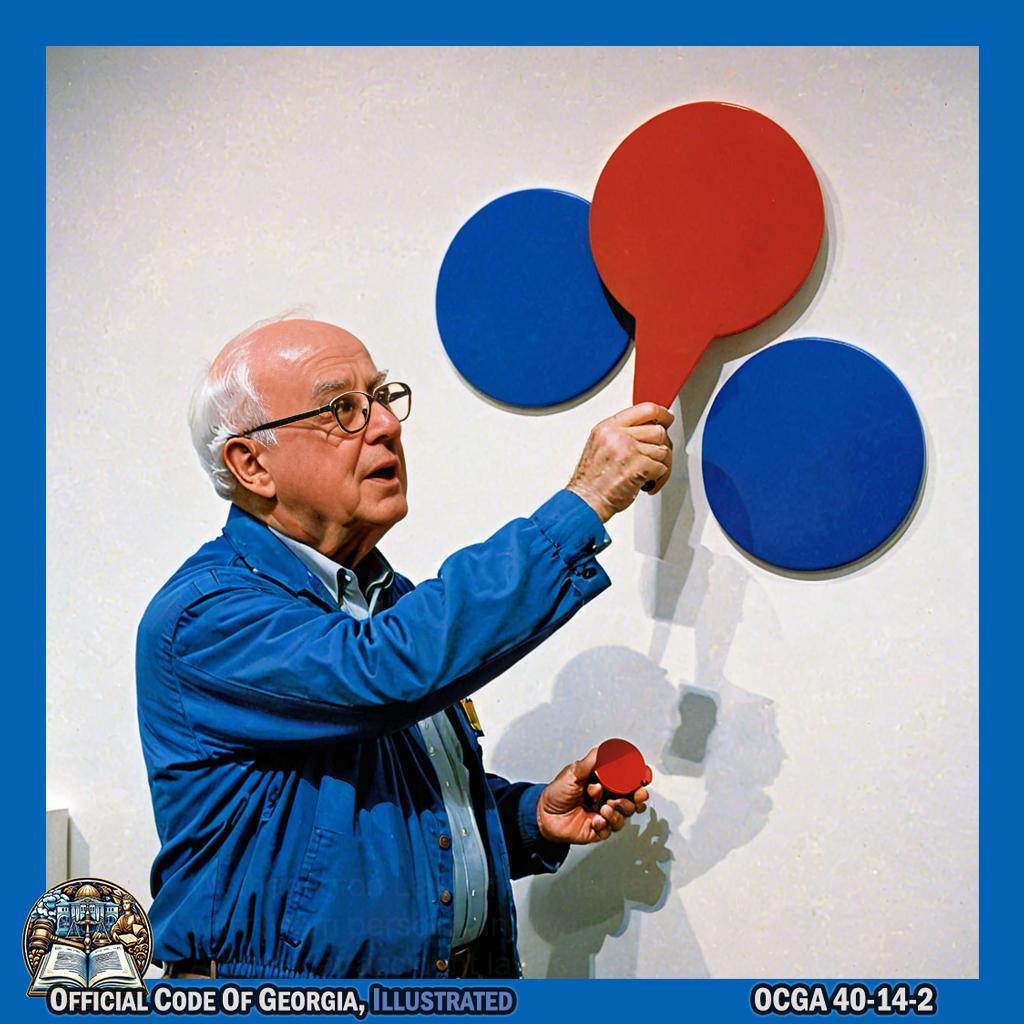
Philosopher Robert Arrington points a toy speed detection device while making a "beep beep" sound, as if holding a badge, in an art piece reminiscent of Ellsworth Kelly's style.
40-14-3.Application for permit; use of device while application pending.¶
- A county sheriff, county or municipal governing authority, or the president of a college or university may apply to the Department of Public Safety for a permit to authorize the use of speed detection devices for purposes of traffic control within such counties, municipalities, colleges, or universities on streets, roads, and highways, provided that such application shall name the street or road on which the device is to be used and the speed limits on such street or road shall have been approved by the Office of Traffic Operations of the Department of Transportation. Law enforcement agencies are authorized to use speed detection devices on streets and roads for which an application is pending as long as all other requirements for the use of speed detection devices are met. Nothing in this subsection shall be construed to affect the provisions of Code Section 40-14-9.
- The Department of Public Safety is authorized to prescribe by appropriate rules and regulations the manner and procedure in which applications shall be made for such permits and to prescribe the required information to be submitted by the applicants. The Department of Public Safety may deny the application or suspend the speed detection device permit for failure to provide information or documentation at the department’s request.
40-14-4.Compliance with rules of Federal Communications Commission; certification of devices.¶
No state, county, municipal, or campus law enforcement agency may use speed detection devices unless the agency possesses a license in compliance with Federal Communications Commission rules, and unless each device, before being placed in service and annually after being placed in service, is certified for compliance by a technician possessing a certification as required by the Department of Public Safety.
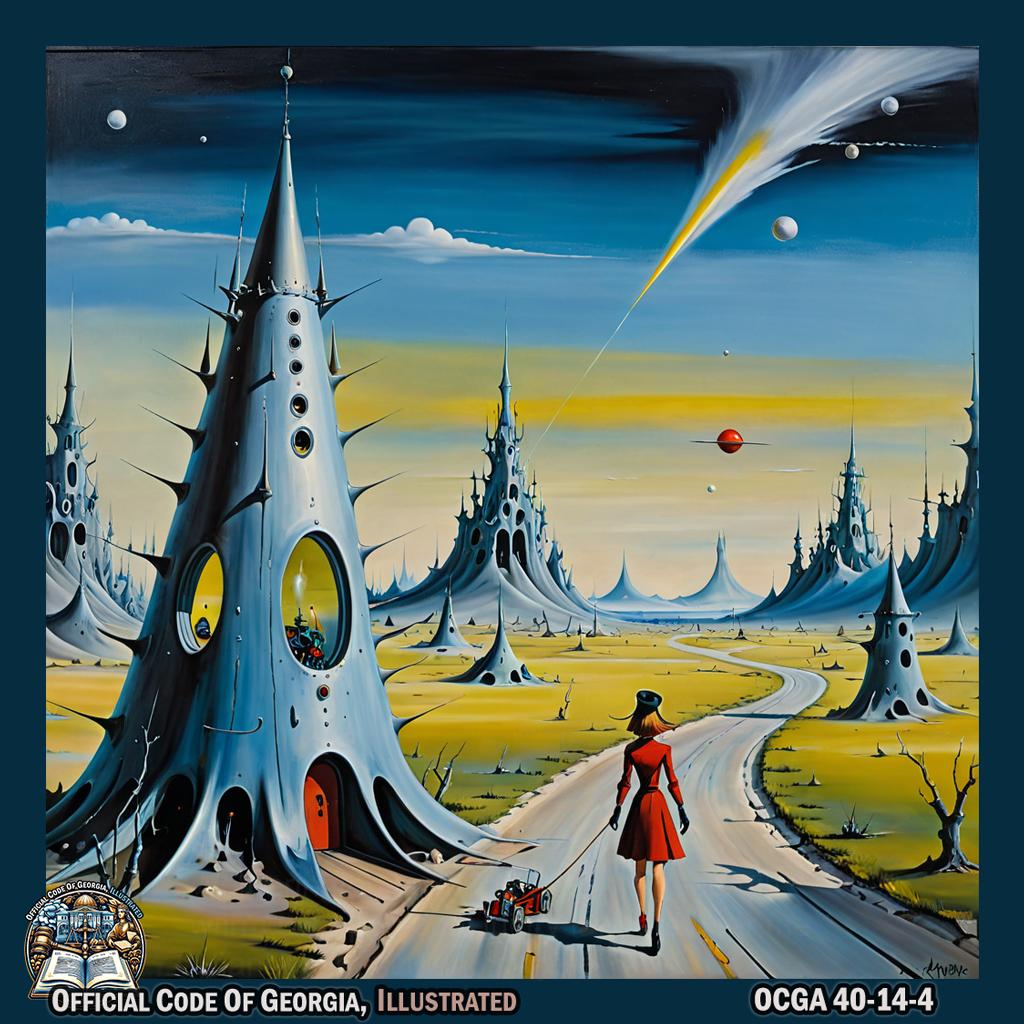
40-14-5.Testing of radar devices; removal of inaccurate radar devices from service; maintenance of testing log and independent calibration tests of automated traffic enforcement devices.¶
-
Each state, county, municipal, or campus law enforcement officer using a radar device, except for an automated traffic enforcement safety device as provided for under Code Section 40-14-18, shall test the device for accuracy and record and maintain the results of the test at the beginning and end of each duty tour. Each such test shall be made in accordance with the manufacturer’s recommended procedure. Any radar unit not meeting the manufacturer’s minimum accuracy requirements shall be removed from service and thereafter shall not be used by the state, county, municipal, or campus law enforcement agency until it has been serviced, calibrated, and recertified by a technician with the qualifications specified in Code Section 40-14-4.

In a vibrant mural in Dalton, actor Douglass Watson dramatically gestures as if testing a radar device, surrounded by swirling colors and abstract shapes reminiscent of Blek Le Rat's signature style. -
Each county, municipal, or campus law enforcement officer using a radar device, except for an automated traffic enforcement safety device as provided for under Code Section 40-14-18, shall notify each person against whom the officer intends to make a case based on the use of the radar device that the person has a right to request the officer to test the radar device for accuracy. The notice shall be given prior to the time a citation and complaint or ticket is issued against the person and, if requested to make a test, the officer shall test the radar device for accuracy. In the event the radar device does not meet the minimum accuracy requirements, the citation and complaint or ticket shall not be issued against the person, and the radar device shall be removed from service and thereafter shall not be used by the county, municipal, or campus law enforcement agency until it has been serviced, calibrated, and recertified by a technician with the qualifications specified in Code Section 40-14-4.
-
- The law enforcement agency, or agent on behalf of the law enforcement agency, operating an automated traffic enforcement safety device provided for under Code Section 40-14-18 shall maintain a log for the automated traffic enforcement safety device attesting to the performance of such device’s self-test at least once every 30 days and the results of such self-test pertaining to the accuracy of the automated traffic enforcement safety device. Such log shall be admissible in any court proceeding for a violation issued pursuant to Code Section 40-14-18.
- The law enforcement agency, or agent on behalf of the law enforcement agency, operating an automated traffic enforcement safety device shall perform an independent calibration test on the automated traffic enforcement safety device at least once every 12 months. The results of such calibration test shall be admissible in any court proceeding for a violation issued pursuant to Code Section 40-14-18.
40-14-6.Warning signs required; signage requirements.¶
- Each county, municipality, college, and university using speed detection devices shall erect signs on every highway which comprises a part of the state highway system at that point on the highway which intersects the corporate limits of the municipality, the county boundary, or the boundary of the college or university campus. Such signs shall be at least 24 by 30 inches in area and shall warn approaching motorists that speed detection devices are being employed. No such devices shall be used within 500 feet of any such warning sign erected pursuant to this subsection.
- In addition to the signs required under subsection (a) of this Code section, each county, municipality, college, and university using speed detection devices shall erect speed limit warning signs on every highway which comprises a part of the state highway system at that point on the highway which intersects the corporate limits of the municipality, the county boundary, or the boundary of the college or university campus. Such signs shall be at least 24 by 30 inches in area, shall warn approaching motorists of changes in the speed limit, shall be visible plainly from every lane of traffic, shall be viewable in any traffic conditions, and shall not be placed in such a manner that the view of such sign is subject to being obstructed by any other vehicle on such highway. No such devices shall be used within 500 feet of any such warning sign erected pursuant to this subsection.
- In addition to the signs required under subsections (a) and (b) of this Code section, each law enforcement agency using an automated traffic enforcement safety device as provided for in Code Section 40-14-18 shall erect signs warning of the use of a stationary speed detection device within the approaching school zone. Such signs shall be at least 24 by 30 inches in area, shall be visible plainly from every lane of traffic, shall be viewable in all traffic conditions, and shall not be placed in such a manner that the view of such sign is subject to being obstructed by any other vehicle on such highway. Such signs shall be placed within 500 feet prior to the warning sign announcing the reduction of the speed limit for the school speed zone. There shall be a rebuttable presumption that such signs are properly installed pursuant to this subsection at the time of any alleged violation under this article.
40-14-7.Visibility of vehicle from which device is operated.¶
Except as provided for in Code Section 40-14-18, no stationary speed detection device shall be employed by county, municipal, college, or university law enforcement officers where the vehicle from which the device is operated is obstructed from the view of approaching motorists or is otherwise not visible for a distance of at least 500 feet.

40-14-8.When case may be made and conviction had.¶
- No county, city, or campus officer shall be allowed to make a case based on the use of any speed detection device, unless the speed of the vehicle exceeds the posted speed limit by more than ten miles per hour and no conviction shall be had thereon unless such speed is more than ten miles per hour above the posted speed limit.
- The limitations contained in subsection (a) of this Code section shall not apply in properly marked school zones one hour before, during, and one hour after the normal hours of school operation or programs for care and supervision of students before school, after school, or during vacation periods as provided for under Code Section 20-2-65, in properly marked historic districts, and in properly marked residential zones. For purposes of this chapter, thoroughfares with speed limits of 35 miles per hour or more shall not be considered residential districts. For purposes of this Code section, the term “historic district” means a historic district as defined in paragraph (5) of Code Section 44-10-22 and which is listed on the Georgia Register of Historic Places or as defined by ordinance adopted pursuant to a local constitutional amendment.
40-14-9.Certain evidence inadmissible; use of device on hill.¶
Evidence obtained by county or municipal law enforcement officers in using speed detection devices within 300 feet of a reduction of a speed limit inside an incorporated municipality or within 600 feet of a reduction of a speed limit outside an incorporated municipality or consolidated city-county government shall be inadmissible in the prosecution of a violation of any municipal ordinance, county ordinance, or state law regulating speed; nor shall such evidence be admissible in the prosecution of a violation as aforesaid when such violation has occurred within 30 days following a reduction of the speed limit in the area where the violation took place, except that this 30 day limitation shall not apply to a speeding violation within a highway work zone, as defined in Code Section 40-6-188, or in an area with variable speed limits, as defined in Code Section 40-6-182. No speed detection device shall be employed by county, municipal, or campus law enforcement officers on any portion of any highway which has a grade in excess of 7 percent.

40-14-10.Unlawful use of devices generally.¶
It shall be unlawful for speed detection devices to be used in any county or municipality or on any campus for which a permit authorizing such use has not been issued or for which a permit authorizing such use has been suspended or revoked and not reissued. It shall be unlawful for any official of such county, municipality, college, or university to order such speed detection devices to be used. It shall be unlawful for any law enforcement officer of any such county, municipality, college, or university to use any such speed detection devices. Any such official or law enforcement officer violating this Code section shall be guilty of a misdemeanor.
40-14-11.Investigations by commissioner of public safety; issuance of order suspending or revoking permit; ratio of speeding fines to agency’s budget.¶
-
Upon a complaint being made to the commissioner of public safety that any county, municipality, college, or university is employing speed detection devices for purposes other than the promotion of the public health, welfare, and safety or in a manner which violates this chapter or violates its speed detection device permit, the commissioner or the commissioner’s designee is authorized and empowered to conduct an investigation into the acts and practices of such county, municipality, college, or university with respect to speed detection devices. If, as a result of this investigation, the commissioner or the commissioner’s designee finds that there is probable cause to suspend or revoke the speed detection device permit of such county, municipality, college, or university, he or she shall issue an order to that effect.
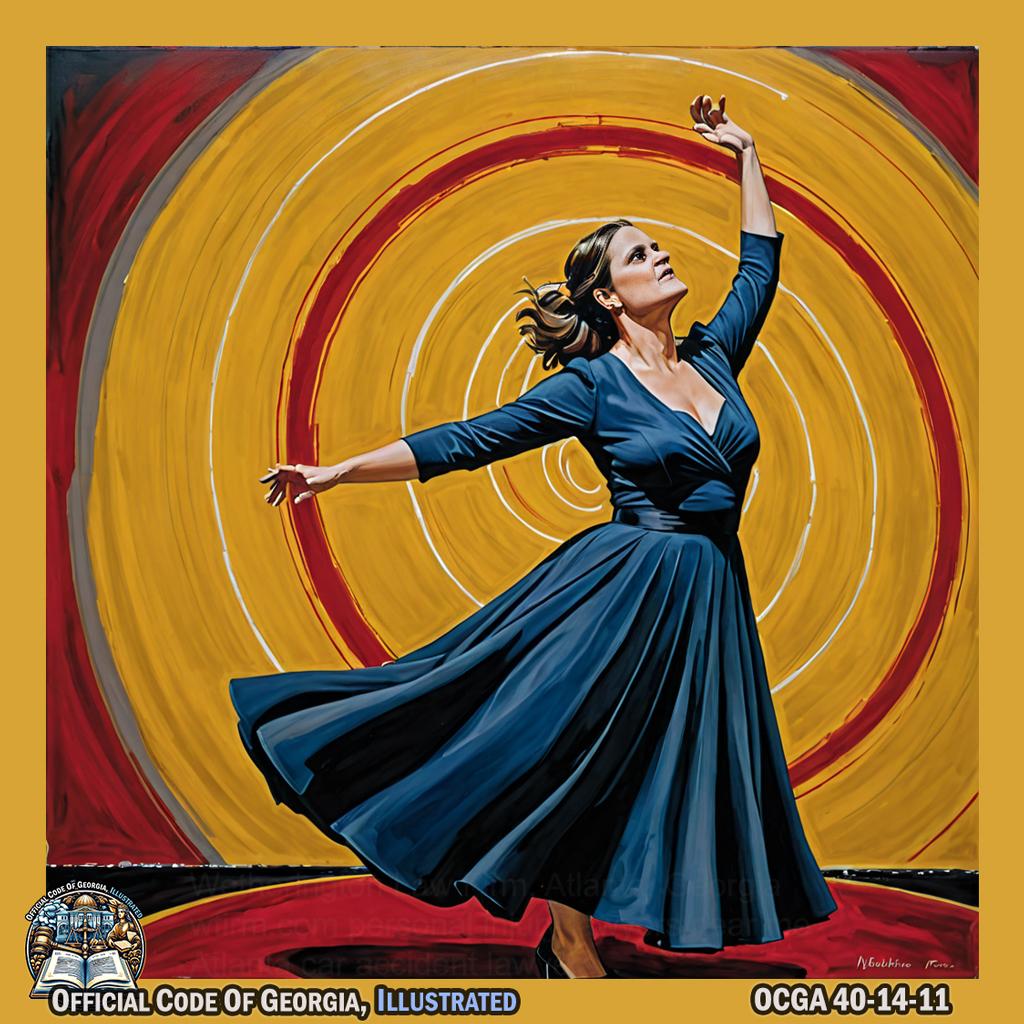
Madeleine Peyroux elegantly twirls and spins, embodying the power of investigation as she gracefully conducts a symphony with her movements, symbolizing the process of uncovering and addressing misuse of speed detection devices in a captivating art piece set against the backdrop of Columbus. -@mpeyrouxmusic -
Upon the suspension or revocation of any speed detection device permit for the reasons set forth in this Code section, the commissioner of public safety shall notify the executive director of the Georgia Peace Officer Standards and Training Council of the action taken.
- Upon receipt from the executive director of the Georgia Peace Officer Standards and Training Council that an officer’s certification to operate speed detection devices has been withdrawn or suspended pursuant to Code Section 35-8-12, the commissioner of public safety or the commissioner’s designee shall suspend the speed detection device permit for the employing agency. The period of suspension or revocation shall be consistent with the action taken by the Georgia Peace Officer Standards and Training Council.
- There shall be a rebuttable presumption that a law enforcement agency is employing speed detection devices for purposes other than the promotion of the public health, welfare, and safety if the fines levied based on the use of speed detection devices for speeding offenses are equal to or greater than 35 percent of a municipal or county law enforcement agency’s budget. For purposes of this Code section, fines collected for citations issued for violations of Code Section 40-6-180 shall be included when calculating total speeding fine revenue for the agency; provided, however, that fines for speeding violations exceeding 20 miles per hour over the established speed limit and civil monetary penalties for speeding violations issued pursuant to Code Section 40-14-18 shall not be considered when calculating total speeding fine revenue for the agency.
40-14-12.Administrative hearing upon permit suspension or revocation.¶
Upon issuance by the commissioner of public safety of an order suspending or revoking the speed detection device permit of any county, municipality, college, or university, the county, municipality, college, or university affected shall be afforded a hearing, to be held within ten days of the effective date of the order. The hearing shall be held before the commissioner or deputy commissioner of public safety, and, following the hearing, the county, municipality, college, or university affected shall be served with a written decision announcing whether the permit shall remain revoked or whether it shall be reinstated.
40-14-13.Administrative and judicial appeal of decision suspending or revoking permit.¶
Any county, municipality, college, or university aggrieved by a decision of the commissioner or deputy commissioner of public safety suspending or revoking its speed detection device permit may appeal that decision within 30 days of its effective date to the Board of Public Safety, which shall schedule a hearing with respect thereto before the board. Following a hearing before the board, the county, municipality, college, or university affected shall be served with a written decision announcing whether the permit shall remain revoked or whether it shall be reinstated. An adverse decision of the board may be appealed by the county, municipality, college, or university to the superior court with appropriate jurisdiction, but the municipality, county, college, or university shall be denied the use of the speed detection device until after such appeal is decided by the court.

40-14-14.Petition for reconsideration following permit suspension or revocation.¶
At the expiration of six months following the suspension or revocation of a speed detection device permit by the Board of Public Safety or, if no appeal was taken, by the commissioner or deputy commissioner of public safety, the governing authority of any such county or municipality or the president of any such college or university may, upon a change of circumstances being shown to the commissioner, petition the commissioner for a reconsideration of whether such county, municipality, college, or university should be permitted to use speed detection devices within their respective jurisdictions.
40-14-15.Rehearing or restoration of permit at direction of Governor.¶
The Governor, in his discretion, may direct the commissioner of public safety, or his delegate, to inquire into such change of circumstances and report the same to him together with any recommendations he might have. The Governor, in his discretion, may order a new hearing on the matter before the Board of Public Safety or may, without hearing, issue his order directing the commissioner to grant a permit to such a county, municipality, college, or university to use speed detection devices. If a county, municipality, college, or university shall not be granted a permit to use such devices, it shall not apply for a rehearing until the expiration of six months.

40-14-16.Restrictions on suspension or revocation of drivers’ licenses; reports to Department of Driver Services to specify speed.¶
No speeding violation of less than ten miles per hour above the legal speed limit in the county or municipality or on a college or university campus in which a person is given a speeding ticket shall be used by the Department of Driver Services for the purpose of suspending or revoking the driver’s license of the violator. No speeding violation report by a county, municipality, or college or university campus to the Department of Driver Services which fails to specify the speed of the violator shall be used by the Department of Driver Services to revoke the driver’s license of a violator.
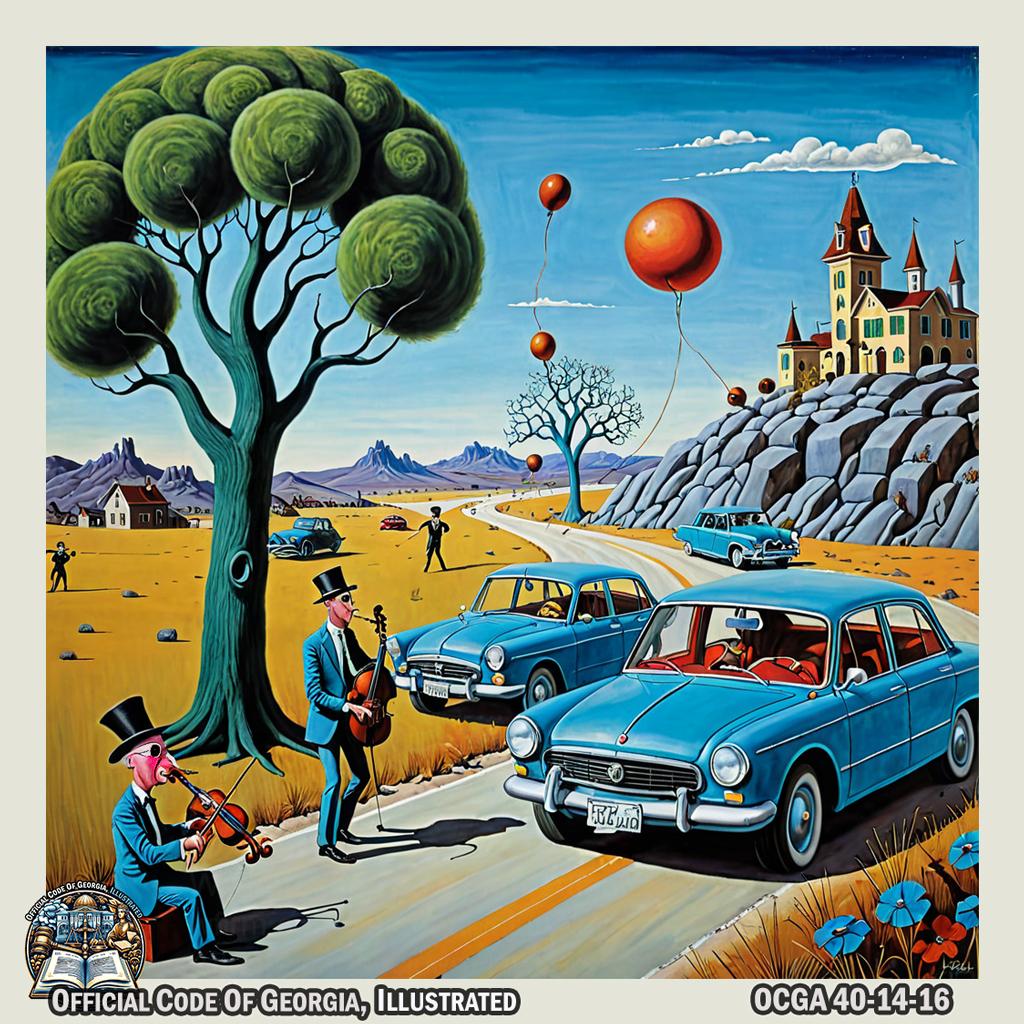
40-14-17.Laser devices; reliability and admissibility of evidence.¶
Evidence of speed based on a speed detection device using the speed timing principle of laser which is of a model that has been approved by the Department of Public Safety shall be considered scientifically acceptable and reliable as a speed detection device and shall be admissible for all purposes in any court, judicial, or administrative proceedings in this state. A certified copy of the Department of Public Safety list of approved models of such laser devices shall be self-authenticating and shall be admissible for all purposes in any court, judicial, or administrative proceedings in this state.
40-14-18.Enforcement of speed limit in school zones with recorded images; civil monetary penalty; vehicle registration and transfer of title restrictions for failure to pay penalty.¶
-
-
The speed limit within any school zone as provided for in Code Section 40-14-8 and marked pursuant to Code Section 40-14-6 may be enforced by using photographically recorded images for violations which occurred only on a school day during the time in which instructional classes are taking place and one hour before such classes are scheduled to begin and for one hour after such classes have concluded when such violations are in excess of ten miles per hour over the speed limit.
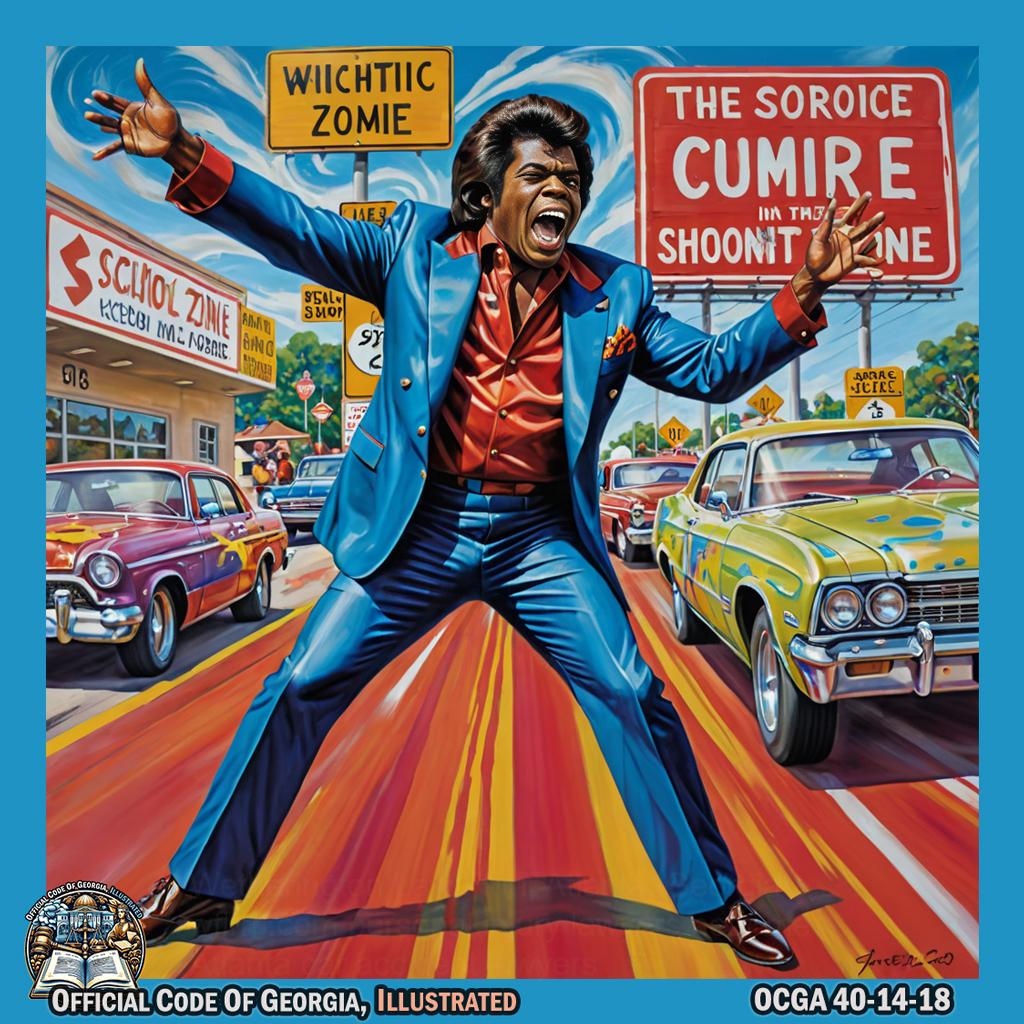
James Brown, dressed in vibrant colors and moving with rhythmic energy, gestures wildly at a large hourglass while surrounded by swirling images of speeding cars and school zone signs, all set against a backdrop of vividly painted pottery. -
Prior to the placement of a device within a school zone, each school within whose school zone such automated traffic enforcement safety device is to be placed shall first apply for and secure a permit from the Department of Transportation for the use of such automated traffic enforcement safety device. Such permit shall be awarded based upon need. The Department of Transportation shall promulgate rules and regulations for the implementation of this paragraph.
-
-
For the purpose of enforcement pursuant to this Code section:

Thomas Davis, in a poised stance, holds up an open book towards the audience while pointing to a symbolic representation of the "Code section," such as a gavel or scales of justice, against the backdrop of Valdosta's historic courthouse, captured with Mapplethorpe's dramatic lighting and composition. -@ThomasDavisSDTM -
The owner of a motor vehicle shall be liable for a civil monetary penalty to the governing body of the law enforcement agency provided for in paragraph (2) of this subsection if such vehicle is found, as evidenced by photographically recorded images, to have been operated in disregard or disobedience of the speed limit within any school zone and such disregard or disobedience was not otherwise authorized by law. The amount of such civil monetary penalty shall be $75.00 for a first violation and $125.00 for a second or any subsequent violation, in addition to fees associated with the electronic processing of such civil monetary penalty which shall not exceed $25.00; provided, however, that for a period of 30 days after the first automated traffic enforcement safety device is introduced by a law enforcement agency within a school zone, the driver of a motor vehicle shall not be liable for a civil monetary penalty but shall be issued a civil warning for disregard or disobedience of the speed limit within the school zone;
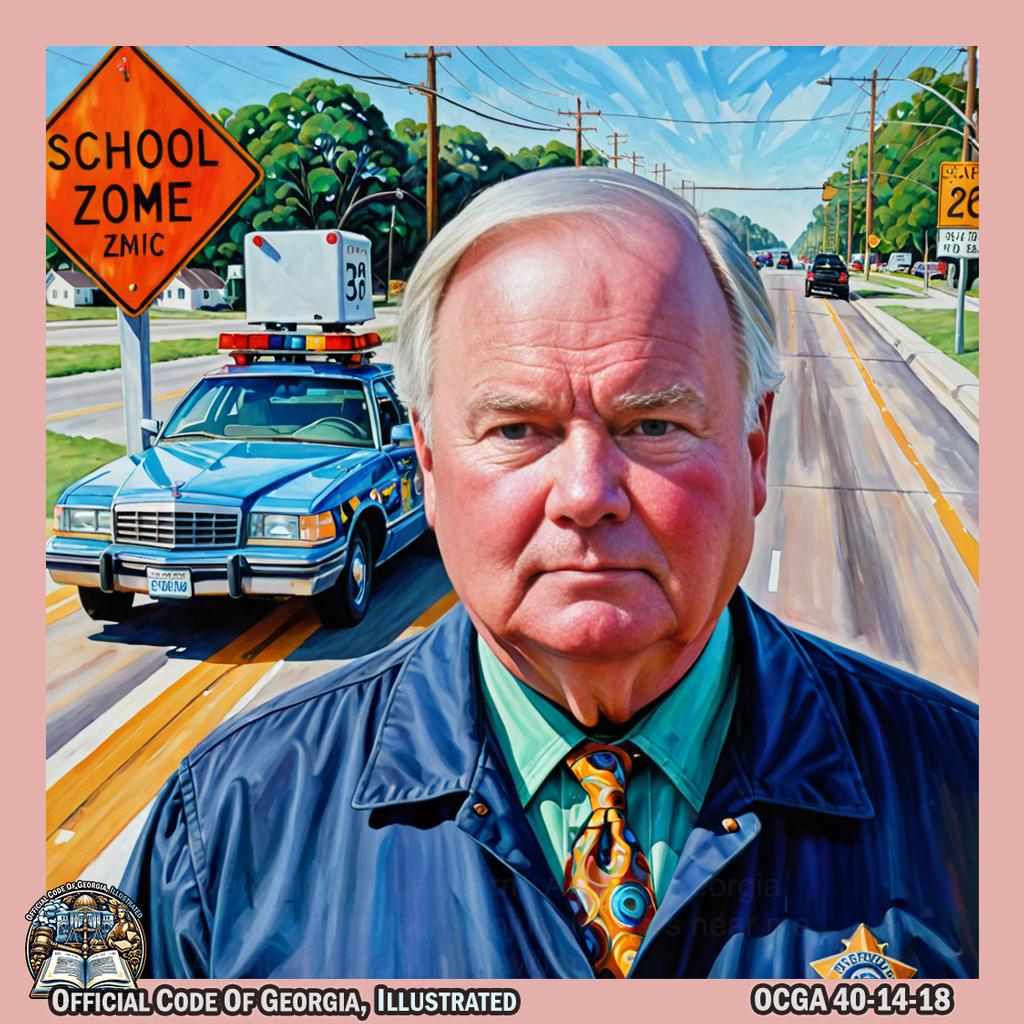
Pat Conroy standing in a school zone, driving over the speed limit with a serious expression as he's caught on camera by an automated traffic enforcement safety device, surrounded by vibrant colors and intricate patterns reminiscent of Georgia O'Keeffe's style. -
A law enforcement agency authorized to enforce the speed limit of a school zone, or an agent working on behalf of a law enforcement agency or governing body, shall send by first class mail addressed to the owner of the motor vehicle within 30 days after obtaining the name and address of the owner of the motor vehicle but no later than 60 days after the date of the alleged violation:
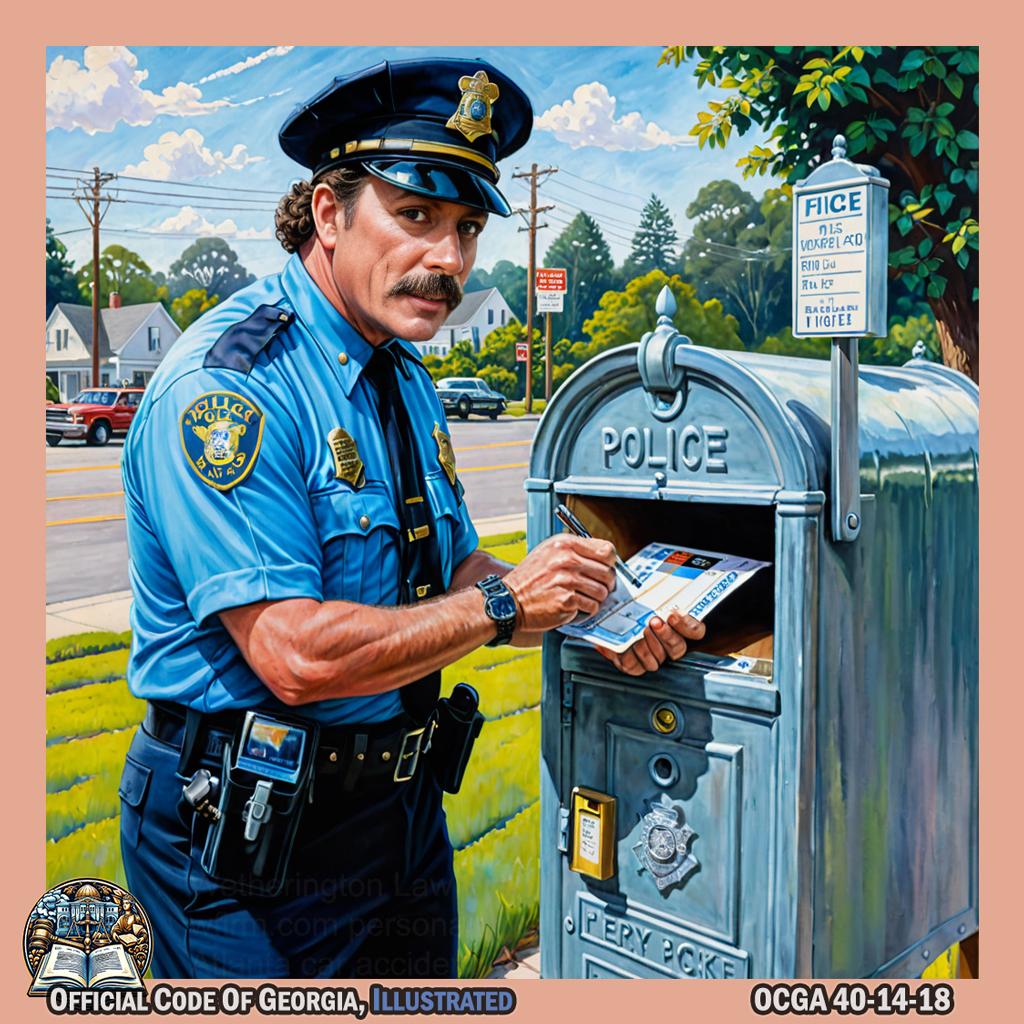
Singer John Michael "Mickey" Thomas embodies the role of a police officer writing a fictitious ticket and depositing it into an ethereal mailbox, creating a scene reminiscent of David Herbert's artwork. -@Mickey_Thomas - A citation for the alleged violation, which shall include the date and time of the violation, the location of the infraction, the maximum speed at which such motor vehicle was traveling in photographically recorded images, the maximum speed applicable within such school zone, the civil warning or the amount of the civil monetary penalty imposed, and the date by which a civil monetary penalty shall be paid;
- An image taken from the photographically recorded images showing the vehicle involved in the infraction;
-
A website address where photographically recorded images showing the vehicle involved in the infraction and a duplicate of the information provided for in this paragraph may be viewed;

Actress Noureen DeWulf performs the action of looking through a pretend camera and pointing to a pretend website address while making a clicking sound, in an art piece reminiscent of John Ery Coleman's work. -@noureendewulf -
A copy of a certificate sworn to or affirmed by a certified peace officer employed by a law enforcement agency authorized to enforce the speed limit of the school zone and stating that, based upon inspection of photographically recorded images, the owner’s motor vehicle was operated in disregard or disobedience of the speed limit in the marked school zone and that such disregard or disobedience was not otherwise authorized by law;
- A statement of the inference provided by paragraph (4) of this subsection and of the means specified therein by which such inference may be rebutted;
-
Information advising the owner of the motor vehicle of the manner in which liability as alleged in the citation may be contested through an administrative hearing; and
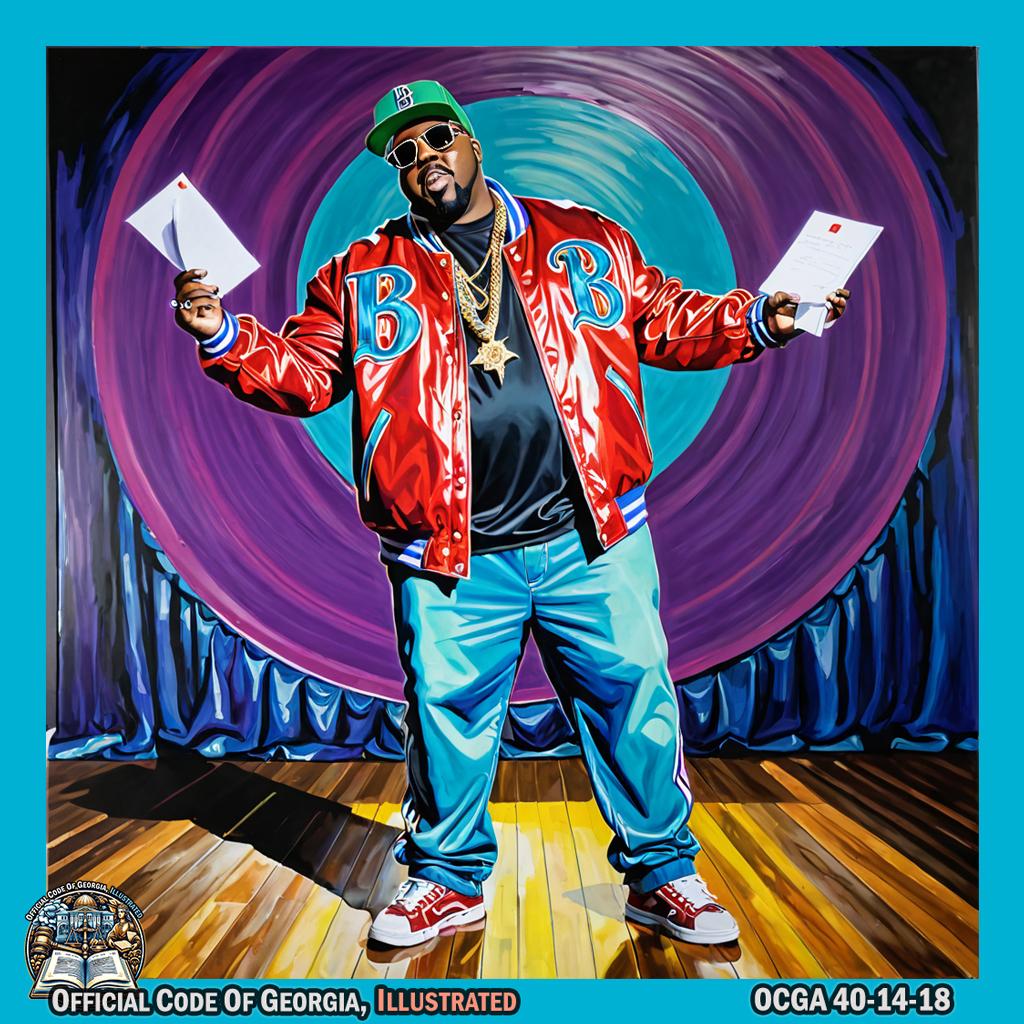
Big Boi stands on a vibrant stage in Villa Rica, gracefully miming the act of receiving a letter and reading it with exaggerated curiosity, all while embodying the dynamic style of Brian Robinson's art. -@BigBoi -
A warning that failure to pay the civil monetary penalty or to contest liability in a timely manner as provided for in subsection (d) of this Code section shall waive any right to contest liability;
- Proof that a motor vehicle was operated in disregard or disobedience of the speed limit of the marked school zone shall be evidenced by photographically recorded images. A copy of a certificate sworn to or affirmed by a certified peace officer employed by a law enforcement agency and stating that, based upon inspection of photographically recorded images, a motor vehicle was operated in disregard or disobedience of the speed limit in the marked school zone and that such disregard or disobedience was not otherwise authorized by law shall be prima-facie evidence of the facts contained therein; and
- Liability under this Code section shall be determined based upon a preponderance of the evidence. Prima-facie evidence that the vehicle described in the citation issued pursuant to this Code section was operated in violation of the speed limit of the school zone, together with proof that the defendant was, at the time of such violation, the registered owner of the vehicle, shall permit the trier of fact in its discretion to infer that such owner of the vehicle was the driver of the vehicle at the time of the alleged violation. Such an inference may be rebutted if the owner of the vehicle:
- Testifies under oath in open court or submits to the court a sworn notarized statement that he or she was not the operator of the vehicle at the time of the alleged violation;
- Presents to the court a certified copy of a police report showing that the vehicle had been reported to the police as stolen prior to the time of the alleged violation.
-
-
A violation for which a civil warning or a civil monetary penalty is imposed pursuant to this Code section shall not be considered a moving traffic violation for the purpose of points assessment under Code Section 40-5-57. Such violation shall be deemed noncriminal, and imposition of a civil warning or civil monetary penalty pursuant to this Code section shall not be deemed a conviction and shall not be made a part of the operating record of the person upon whom such liability is imposed, nor shall it be used for any insurance purposes in the provision of motor vehicle insurance coverage.
- If a person issued and mailed a citation pursuant to subsection (b) of this Code section fails to pay the civil monetary penalty for the violation or has not filed a police report or notarized statement pursuant to paragraph (4) of subsection (b) of this Code section in no less than 30 nor more than 60 days after such mailing as determined and noticed by the law enforcement agency, the agent or law enforcement agency shall send to such person by first class mail a second notice of any unpaid civil monetary penalty, except in cases where there is an adjudication that no violation occurred or there is otherwise a lawful determination that no civil monetary penalty shall be imposed. The second notice shall include all information required in paragraph (2) of subsection (b) of this Code section and shall include a new date of return which shall be no less than 30 days after such mailing as determined and noticed by the law enforcement agency. If such person notified by second notice again fails to pay the civil monetary penalty or file a police report or notarized statement pursuant to paragraph (4) of subsection (b) of this Code section by the new date of return, such person shall have waived the right to contest the violation and shall be liable for the civil monetary penalty provided for under this Code section, except in cases where there is an adjudication that no violation occurred or there is otherwise a lawful determination that no civil monetary penalty shall be imposed.
- Notices mailed by first class mail pursuant to this Code section shall be adequate notification of the fees and penalties imposed by this Code section. No other notice shall be required for the purposes of this Code section.
- Any court having jurisdiction over violations of subsection (a) of this Code section shall have jurisdiction over cases arising under this subsection and shall be authorized to impose the civil monetary penalty provided by this subsection. Except as otherwise provided in this subsection, the provisions of law governing jurisdiction, procedure, defenses, adjudication, appeal, and payment and distribution of penalties otherwise applicable to violations of subsection (a) of this Code section shall apply to enforcement under this Code section except as provided in subsection (b) of this Code section; provided, however, that any appeal from superior or state court shall be by application in the same manner as that provided by Code Section 5-6-35.
- If a violation has not been contested and the assessed penalty has not been paid, the agent or governing body shall send to the person who is the registered owner of the motor vehicle a final notice of any unpaid civil monetary penalty authorized by this Code section, except in cases where there is an adjudication that no violation occurred or there is otherwise a lawful determination that no civil monetary penalty shall be imposed. The notice shall inform the registered owner that the agent or governing body shall send a referral to the Department of Revenue if the assessed penalty is not paid within 30 days after the final notice was mailed and such that such referral shall result in the nonrenewal of the registration of such motor vehicle and shall prohibit the title transfer of such motor vehicle within this state.
-
The agent or governing body shall send a referral to the Department of Revenue not sooner than 30 days after the final notice required under subsection (g) was mailed if a violation of an ordinance or resolution adopted under this article has not been contested and the assessed penalty has not been paid. The referral to the Department of Revenue shall include the following:
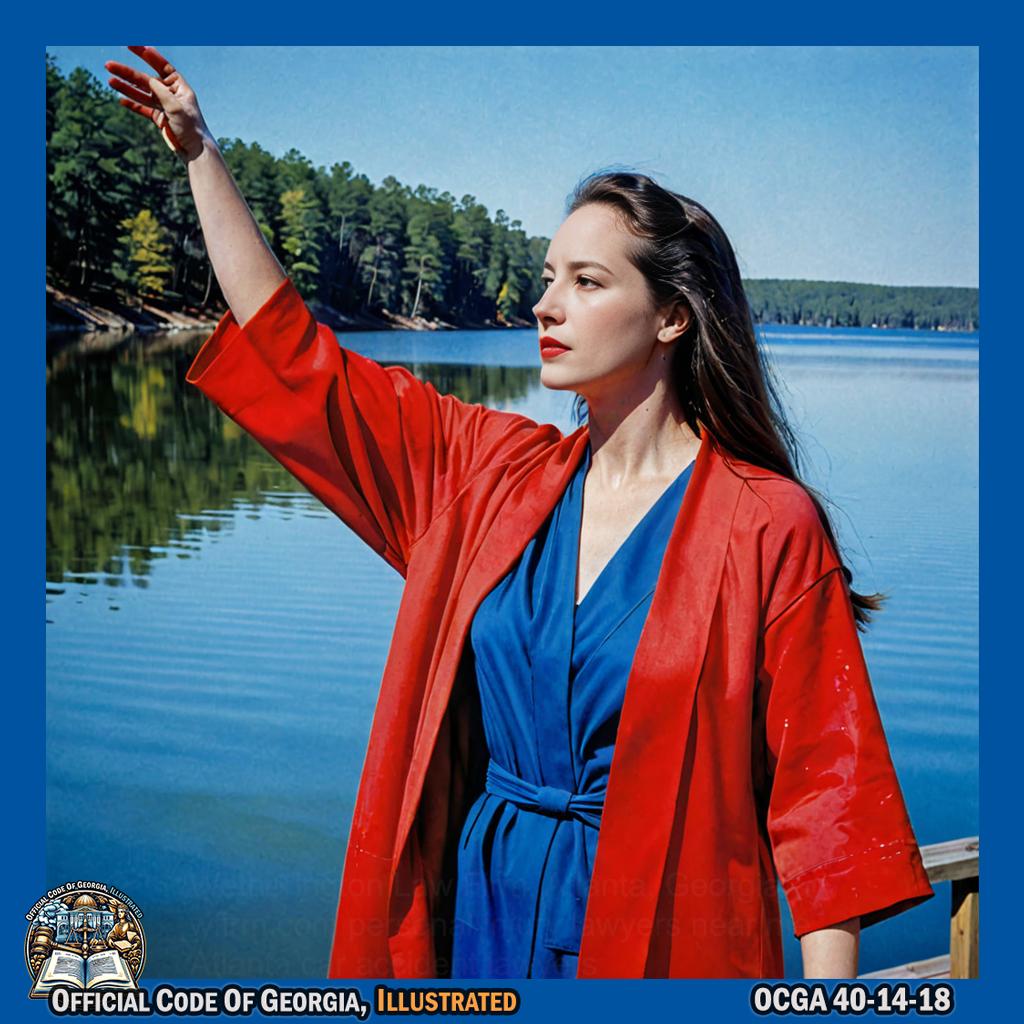
Precious Bryant, wearing a bold, solid-colored robe akin to Barnett Newman's "Who's Afraid of Red, Yellow and Blue," stands by Lake Lanier's shore. She stretches out her arms with one holding an invisible scroll symbolizing the referral as she theatrically gazes towards an imaginary Department of Revenue across the water, poised as if ready to release a carrier pigeon. The background is a vibrant canvas of vertical color fields representing Newman’s "zip" paintings, reflecting off the lake's surface for dramatic effect. - Any information known or available to the agent or governing body concerning the license plate number, year of registration, and the name of the owner of the motor vehicle;
- The date on which the violation occurred;
-
The date when the notice required under this Code section was mailed; and
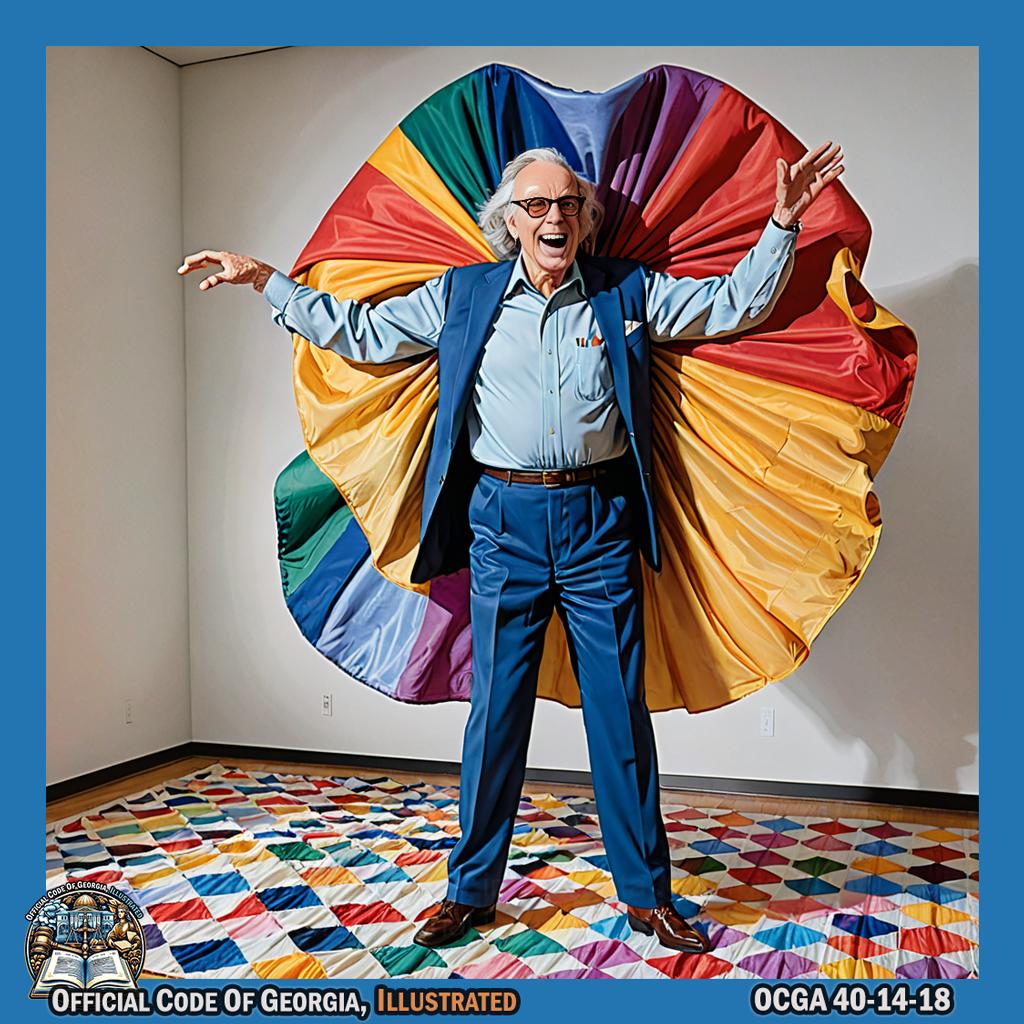
Chuck Willis gracefully dances around a larger-than-life fabric sculpture, miming the act of mailing a letter, while surrounded by billowing and colorful swaths of fabric art in the style of Christo and Jeanne-Claude. -
The seal, logo, emblem, or electronic seal of the governing body.
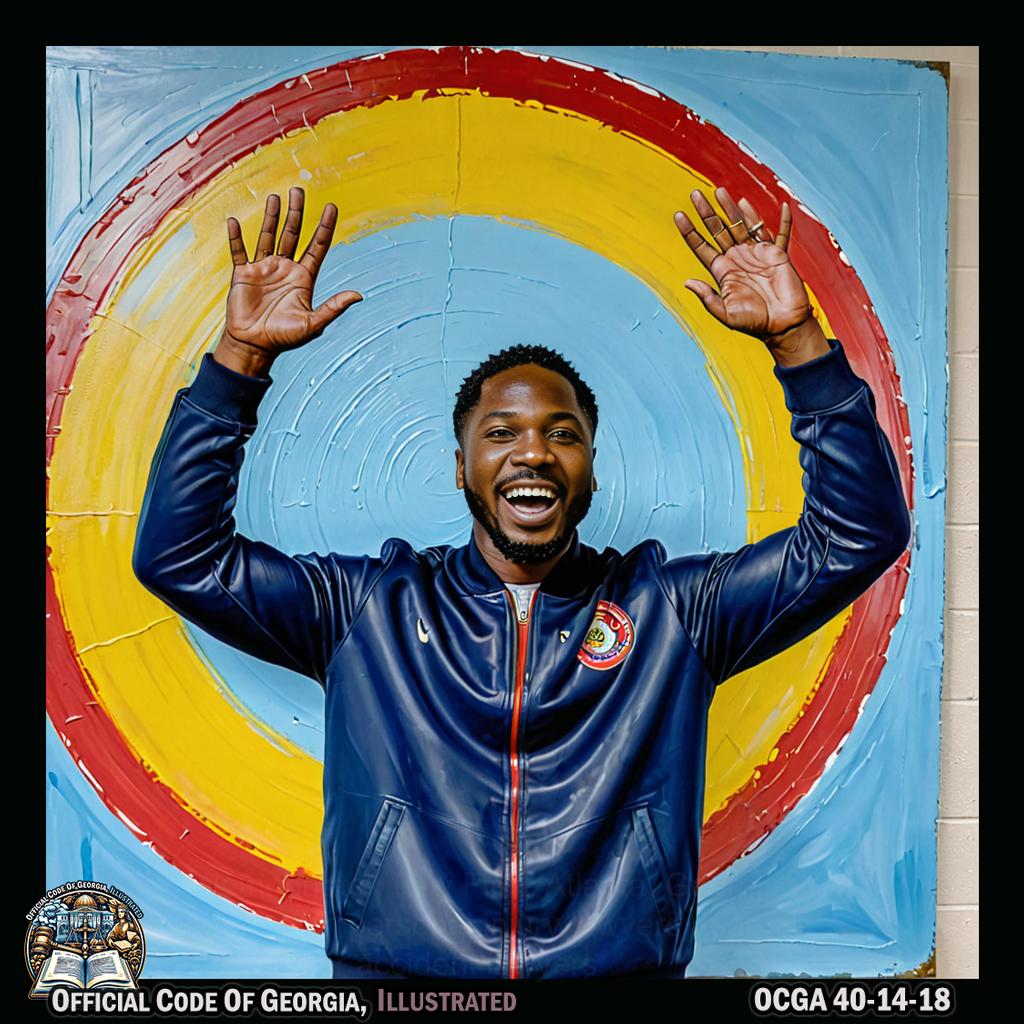
Akeem Dent miming the act of holding up a large, invisible seal emblem with an expression of authority and pride in a vibrant, dynamic art piece inspired by Cusseta. -@AkeemDent
-
If the Department of Revenue receives a referral under subsection (h) of this Code section, such referral shall be entered into the motor vehicle database within five days of receipt and the Department of Revenue shall refuse to renew the registration of the motor vehicle and shall prohibit the title transfer of such vehicle within this state unless and until the civil monetary penalty plus any late fee is paid to the governing body. The Department of Revenue shall mail a notice to the registered owner:
-
That the registration of the vehicle involved in the violation will not be permitted to be renewed;
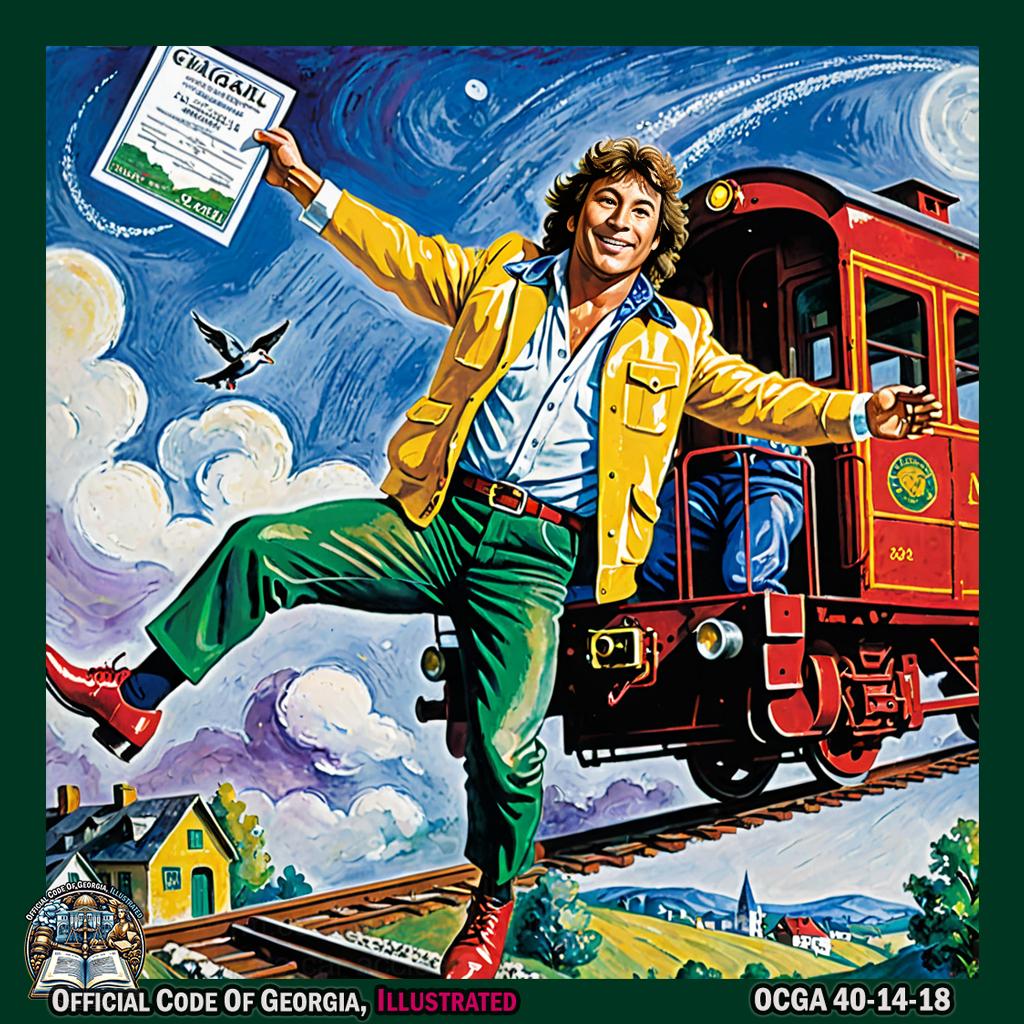
Marty Jannetty, dressed in colorful attire, gracefully leaps over a vintage train car while holding a symbolic vehicle registration document, as if soaring through the sky in the style of Marc Chagall's art. -@JannettyHOF -
That the title of the vehicle involved in the violation will not be permitted to be transferred in this state;
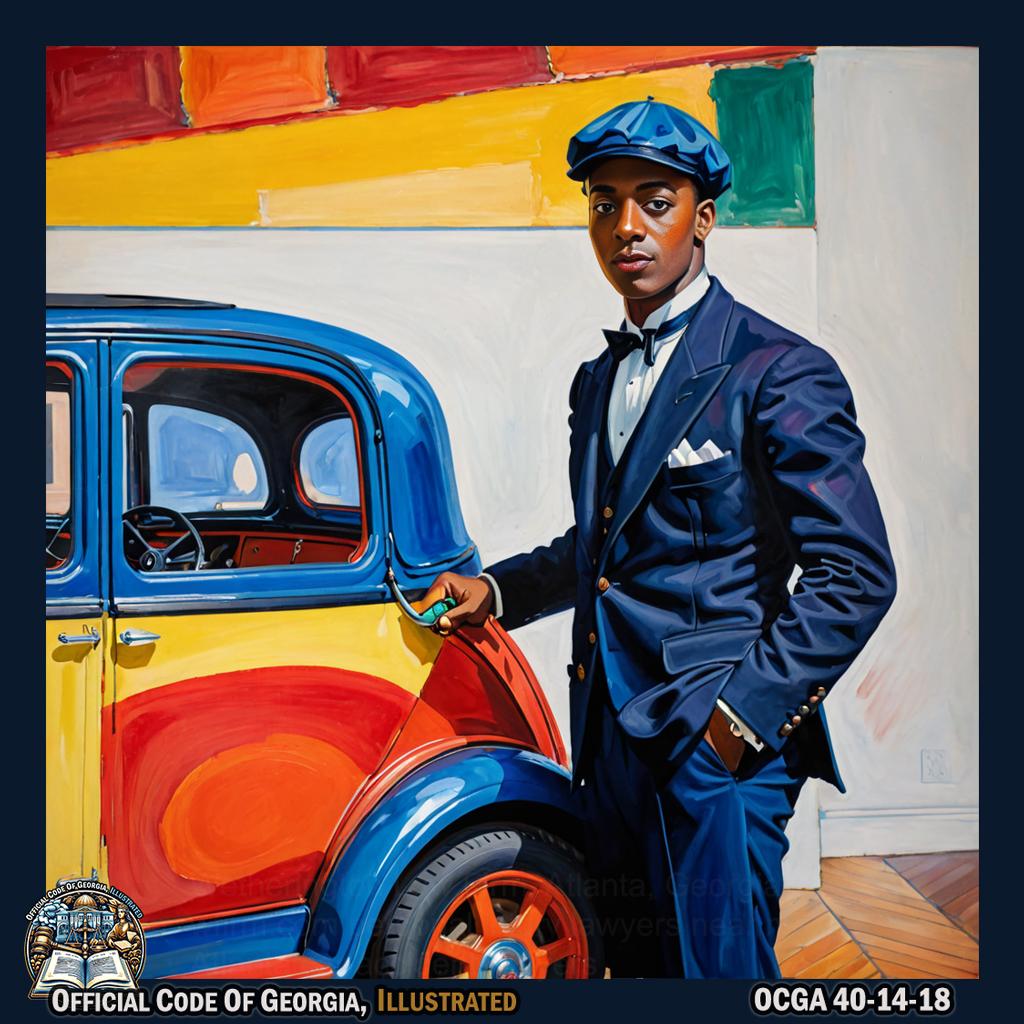
DJ Ware, dressed as a 1920s chauffeur in the vibrant, fauvist style of André Derain, theatrically removes a colorful car key from his pocket and then dramatically drops it into an equally bright painted lockbox, symbolizing the non-transferability of the vehicle title due to a violation; all staged within the expressive and abstract interior of the Gertrude Herbert Institute of Art. -@Djware42 -
That the aforementioned penalties are being imposed due to the failure to pay the civil monetary penalty and any late fee for an ordinance violation adopted under the authority of this Code section; and
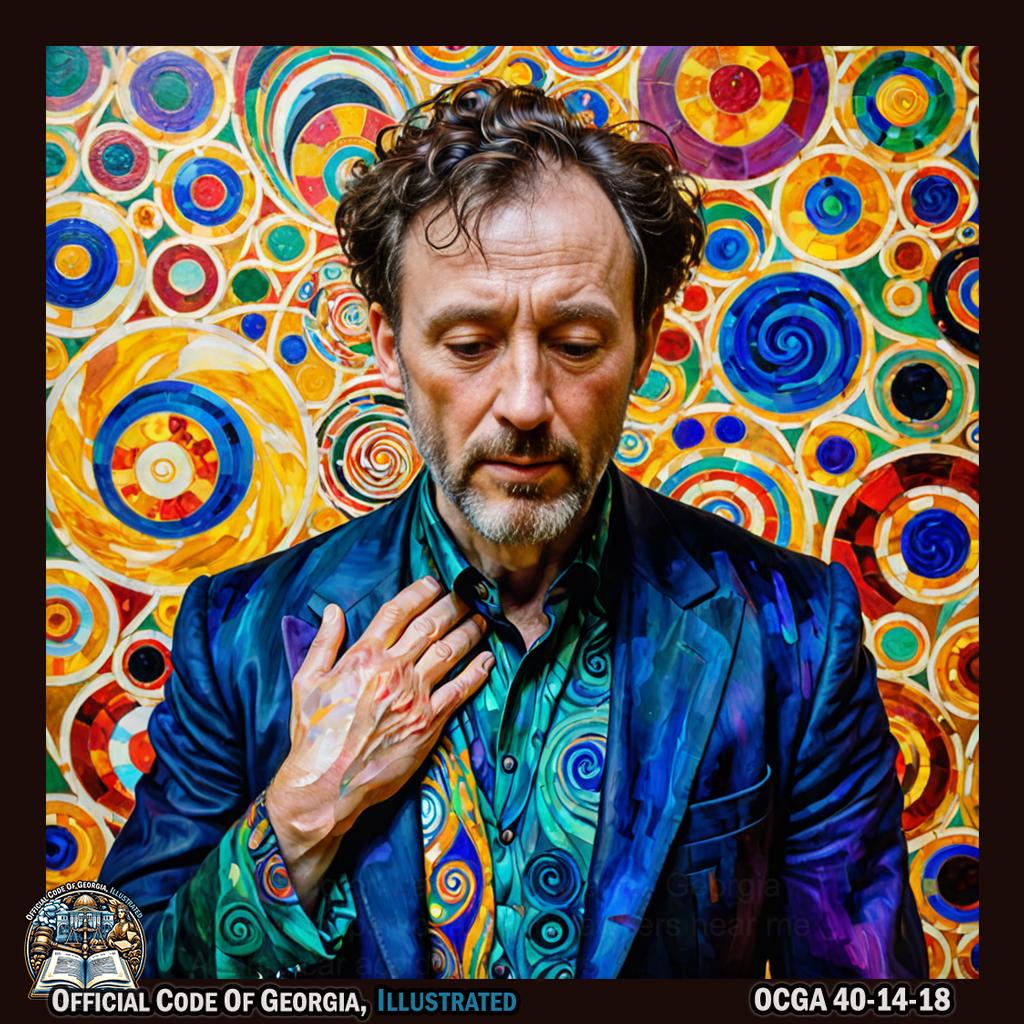
James Neill stands with one hand pressed to his chest, the other reaching out as if pleading for mercy, while tilting his head back in despair, surrounded by swirling patterns and vibrant colors reminiscent of Gustav Klimt's art. -
Of the procedure that the person may follow to remove the penalties.
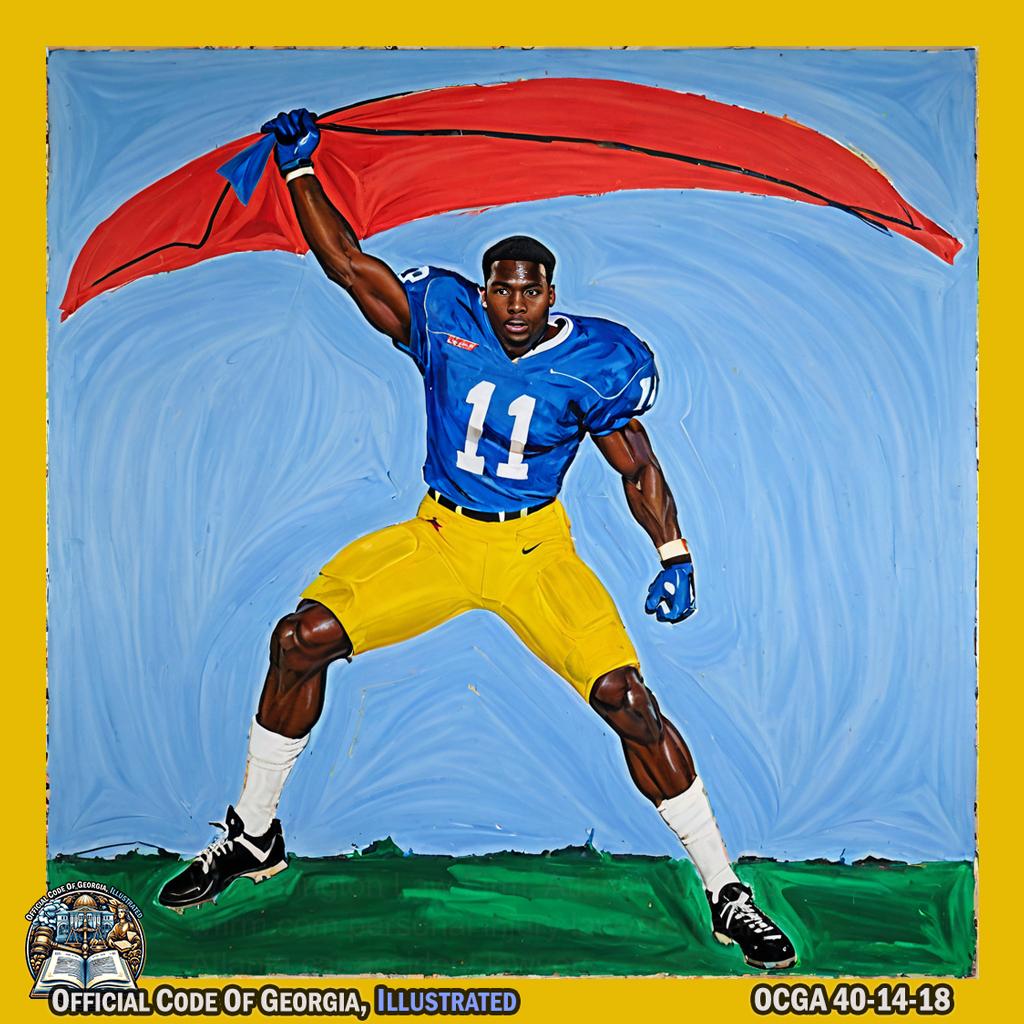
Jonathan Massaquoi, adorned in a vibrant football uniform reminiscent of de Kooning's abstract expressionist style, dramatically enacts lifting heavy penalty flags off the ground and theatrically throwing them into the air where they transform into colorful birds flying away, symbolizing the removal of penalties, all set against the dramatic backdrop of Fantastic Pit with its vast depth adding to the intensity of the scene. -@JohnnyMass94
-
-
The Department of Revenue shall remove the penalties on a vehicle if any person presents the Department of Revenue with adequate proof that the penalty and any late fee, if applicable, has been paid.
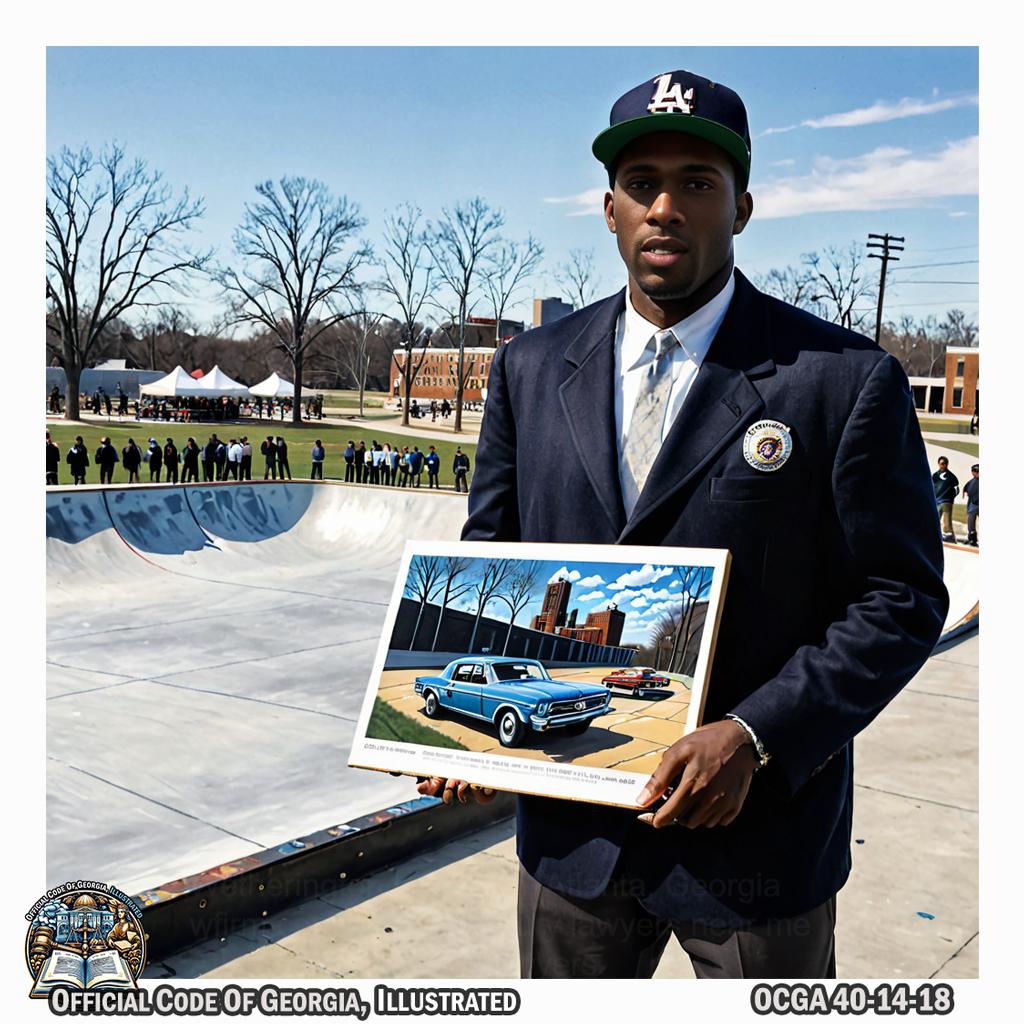
In a dramatic and dynamic scene at the Historic Fourth Ward Skate Park, football player Allen Bailey gracefully presents the Department of Revenue with proof of payment for vehicle penalties, embodying the spirit of Berenice Abbott's art in a powerful physical display. -@AllenBailey57 -
Recorded images made for purposes of this Code section shall not be a public record for purposes of Article 4 of Chapter 18 of Title 50.
- A civil warning or civil monetary penalty under this Code section on the owner of a motor vehicle shall not be imposed if the operator of the vehicle was arrested or issued a citation and notice to appear by a certified peace officer for the same violation.
- The money collected and remitted to the governing body pursuant to paragraph (1) of subsection (b) of this Code section shall only be used by such governing body to fund local law enforcement or public safety initiatives. This subsection shall not preclude the appropriation of a greater amount than collected and remitted under this subsection.
Article 3 Red Light Cameras¶
-
40-14-20. Definitions.

Keri Hilson, in a rich scene at the Tubman African American Museum in Georgia, opens an imaginary large book, points to a word, scratches her head in confusion before having a lightbulb moment and excitedly jumps up with a finger raised as if she's just understood the definition. -@KeriHilson - 40-14-22. Timing of traffic-control signals utilizing monitoring devices.
- 40-14-23. Use of signs to notify motorists of traffic-control signal monitoring devices.
- 40-14-24. Reports on traffic-control signal monitoring device use.
- 40-14-25. Complaints about traffic-control signal monitoring devices; rebuttable presumption; remission of revenues.
- 40-14-26. Revoking traffic-control signal monitoring device permit; hearing; reconsideration.
40-14-20.Definitions.¶
As used in this article, the term:
- “Governing authority” means any county, municipality, or consolidated government.
- “Recorded images” has the meaning provided in subparagraph (f)(1)(B) of Code Section 40-6-20.
- “Traffic-control signal monitoring device” has the meaning provided in subparagraph (f)(1)(C) of Code Section 40-6-20.
40-14-21.Traffic-control signal monitoring devices; application and permit for operation; collection and use of civil monetary penalty; inspection of devices.¶
- A governing authority must obtain an operating permit from the Department of Transportation prior to using any traffic-control signal monitoring device. The governing authority shall not use traffic-control signal monitoring devices unless the chief law enforcement officer of such governing authority desires the use of such devices and such use is approved by a properly adopted resolution of the governing authority.
- The governing authority shall also conduct a public hearing on the proposed use of such devices prior to entering any contract on or after July 1, 2001, for the use or purchase of such devices.
- The Department of Transportation is authorized to prescribe by appropriate rules and regulations the manner and procedure in which applications shall be made for traffic-control signal monitoring device permits and to prescribe the required information to be submitted by an applicant consistent with the requirements of this title. The Department of Transportation may deny an application or suspend or revoke a permit for failure of the governing authority to provide requested information or documentation or for any other violation of this article or violation of the rules and regulations of the department.
-
An application for the operation of a traffic-control signal monitoring device by a governing authority shall name the intersection at which the device is to be used and provide demonstrable evidence that there is a genuine safety need for the use of such device at the designated intersection. The documented safety need for each designated intersection shall be approved by the Department of Transportation in accordance with nationally recognized safety standards. For each designated intersection, the governing authority shall conduct a traffic engineering study to determine whether, in addition to or as an alternative to the traffic-control signal monitoring device, there are other possible design or operational changes likely to reduce the number of accidents or red light violations at that intersection. This report shall be submitted with the application for an operation permit required under these provisions and any request to amend the operation permit to include an additional intersection.

Young Thug theatrically examines a large, colorful map of intersections at an exaggeratedly cluttered desk, dotted with miniature traffic lights and cars. He then dramatically points to an intersection on the map, nods decisively, and mimics taking photos for evidence while assistants measure the roads with oversized rulers. He proceeds to act out a traffic study by observing toy cars navigating through the intersection and jotting down notes on a giant clipboard. Finally, he pretends to seal an enormous envelope (sans words or letters) symbolizing the application and mockingly walks it over to a larger-than-life mailbox marked "DOT" with vibrant patterns akin to Lori K. Gordon's art style. -@youngthug -
The revenue generated by the use of a traffic-control signal monitoring device shall not be considered when determining whether to issue a permit for the operation of such devices at a designated intersection. The only consideration shall be the increased life-saving safety value by the use of such a device at the designated intersection.
- Permits shall be issued by the Department of Transportation within three months of receiving a completed permit application from a governing authority where such governing authority is otherwise in compliance with the provisions of this article. An application for amendment to an existing permit and an application for a renewal permit following a suspension or revocation of a permit shall also be processed within three months of receipt of such application, provided that the application is complete and complies with the provisions of this article. A permit shall authorize use of a traffic-control signal monitoring device for only those designated intersections approved as having a documented life-saving safety need by the Department of Transportation.
-
No governing authority shall be authorized to use traffic-control signal monitoring devices where any arresting officer or official of the court having jurisdiction of traffic cases is paid on a fee system. This subsection shall not apply to any official receiving a recording fee.

Mirabeau Lamar dramatically raises his hand in a gesture of prohibition, with the shadow of a traffic control signal casting across his face, as the wind gently sways the surrounding trees and grass. -
If a governing authority elects to use traffic-control signal monitoring devices, no portion of any civil monetary penalty collected through the use of such devices may be paid to the manufacturer or vendor of the traffic-control signal monitoring devices. The compensation paid by the governing authority for such devices shall be based on the value of such equipment and shall not be based on the number of citations issued or the revenue generated by such devices.

Charles Kelley stands in a dramatic pose, holding a large traffic control signal monitoring device above his head, while surrounded by vibrant street art and colorful murals in the Piedmont Heights neighborhood of Atlanta. -@charleskelleyla -
Charges for violations based on evidence obtained from a traffic-control signal monitoring device shall not be made by a law enforcement agency unless the law enforcement agency employs at least one full-time certified peace officer.
- A traffic-control signal monitoring device shall not be used to produce any photograph, microphotograph, electronic image, or videotape showing the identity of any person in a motor vehicle.
- A governing authority utilizing traffic-control signal monitoring devices shall at all times cooperate fully with the Department of Transportation. The department is authorized, at any time, to inspect traffic-control signal monitoring devices used by a governing authority and any records pertaining to revenues collected from the use of such devices.
-
A permit may be amended at any time by amended application submitted by a governing authority. The request to amend an application and to add a new intersection to the list of authorized intersections for the operation of a traffic-control signal monitoring device shall be considered by the department in the same manner as original permit applications.

Judge James Moore Wayne, portrayed in an Elliott Arkin art piece, playfully submits a new application form with colorful markers and then theatrically presses a big imaginary button for approval. -
A permit shall be reviewed by the Department of Transportation once every three years from the date of issuance or date of the most recent extension unless the permit has been revoked or suspended by the department. The review shall be conducted in the same manner as the original permit application.
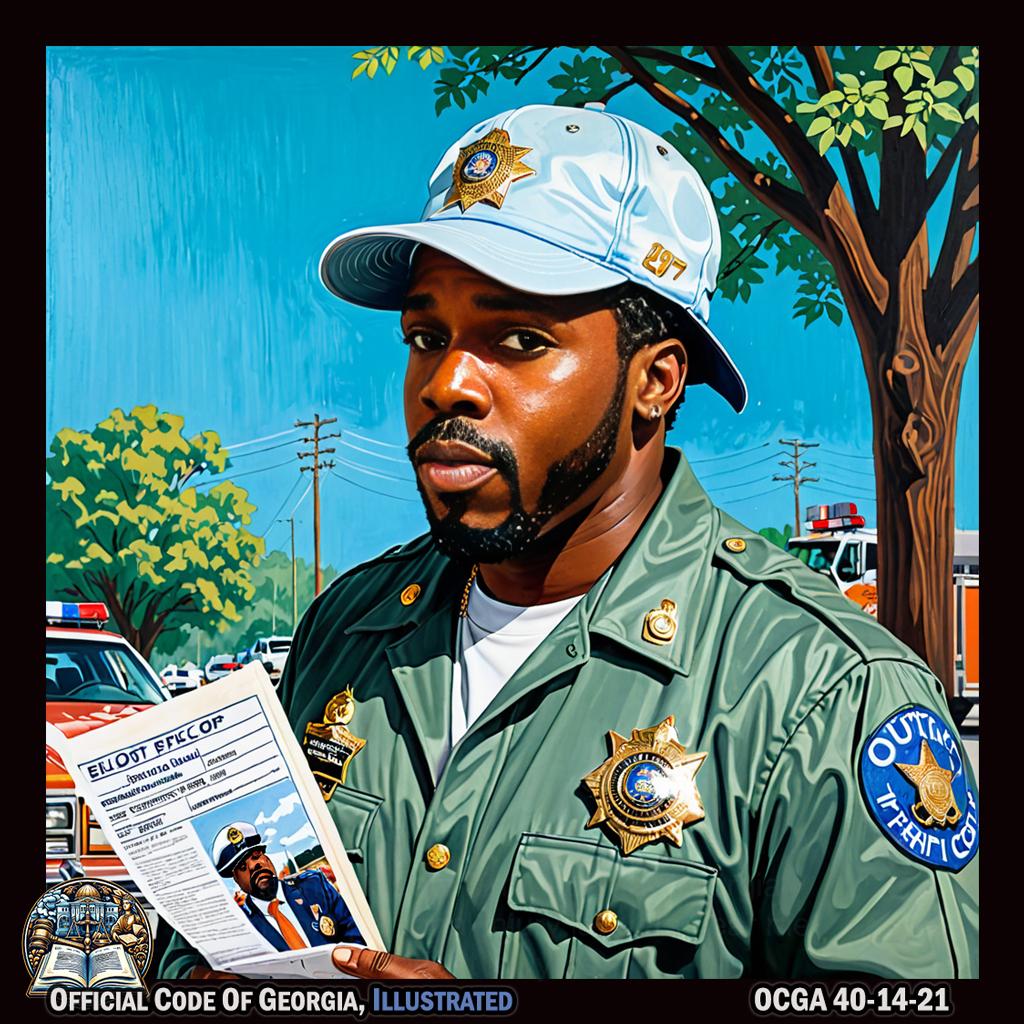
Outkast, portrayed as characters in an art piece by Elliott Johnson, act out the scene of a traffic cop reviewing a permit every three years, stamping and flipping through papers while wearing a comically oversized hat. -@Outkast -
The department is authorized to set reasonable application fees to compensate the department for necessary costs in issuing, amending, or reviewing a permit to operate traffic-control signal monitoring devices.
- Any governing authority operating a traffic-control signal monitoring device on December 31, 2008, shall have until January 1, 2010, to obtain a permit for the operation of such device as required by this Code section.
40-14-22.Timing of traffic-control signals utilizing monitoring devices.¶
The timing of any traffic-control signal which is being monitored by a traffic-control signal monitoring device shall conform to regulations promulgated by the Department of Transportation pursuant to Code Section 32-6-50. The duration of the yellow or red light of any traffic-control device at which a traffic-control signal monitoring device is installed shall not be decreased prior to the installation of a device or during the time for which the device is operated. The Department of Transportation shall establish minimal yellow light change interval times for traffic-control devices at intersections where a traffic-control signal monitoring device is utilized. The minimal yellow light change interval time shall be established in accordance with nationally recognized engineering standards, and any such established time shall not be less than the recognized national standard plus one additional second. Each governing authority using a traffic-control signal monitoring device shall at its own expense test the device for accuracy at regular intervals and record and maintain the results of each test. Such test results shall be public records subject to inspection as provided by Article 4 of Chapter 18 of Title 50. Each such test shall be made in accordance with the manufacturer’s recommended procedure. Any such device not meeting the manufacturer’s minimum accuracy requirements shall be removed from service and thereafter shall not be used by the governing authority, nor shall any charges for violations based on evidence from such device be made by a law enforcement agency, until such device has been serviced and calibrated at the expense of the governing authority by a qualified technician.
40-14-23.Use of signs to notify motorists of traffic-control signal monitoring devices.¶
Each governing authority using traffic-control signal monitoring devices shall erect signs on every highway which comprises a part of the state highway system at that point on the highway which intersects the jurisdictional limits of the governing authority. A sign shall be erected also by such entity on each public road on the approach to the next traffic-control signal for such road when a traffic-control signal monitoring device is monitoring such next signal for such road and signs shall also be erected at any other location required by the Department of Transportation. Such signs shall be of a design specified by the Department of Transportation in accordance with nationally recognized standards.
40-14-24.Reports on traffic-control signal monitoring device use.¶
-
Each governing authority using any traffic-control signal monitoring device shall submit not later than February 1 of each year a report on such use during the preceding calendar year to the Department of Transportation. Such report shall include, without limitation:
- A description of the locations where traffic-control signal monitoring devices were used;
- The number of violations recorded at each location and in the aggregate on a monthly basis;
- The total number of citations issued;
- The number of civil monetary penalties and total amount of such penalties paid after citation without contest;
-
The number of violations adjudicated and results of such adjudications, including a breakdown of dispositions made;

In a lush garden in Oxford, Georgia, rapper Gunna gracefully dances to interpret the sentence "The number of violations adjudicated and results of such adjudications including a breakdown of dispositions made" through fluid movements and expressive gestures, creating an art piece that captivates the audience with its visual storytelling. -@1GunnaGunna -
The total amount of civil monetary penalties paid; and

Gale Harold gracefully sculpts a large, flowing ribbon of fabric into the shape of a dollar sign while slowly and dramatically lowering it to the ground in an artfully dramatic display. -@GaleHaroldIII -
The quality of the adjudication process and its results.
-
If any governing authority fails to provide the report provided for in subsection (a) of this Code section all revenues generated from the operation of any traffic-control signal monitoring device from the date the report was due shall be forwarded to the general fund of the state. The governing authority shall not be entitled to retain any revenue until the annual report is filed and accepted by the Department of Transportation.
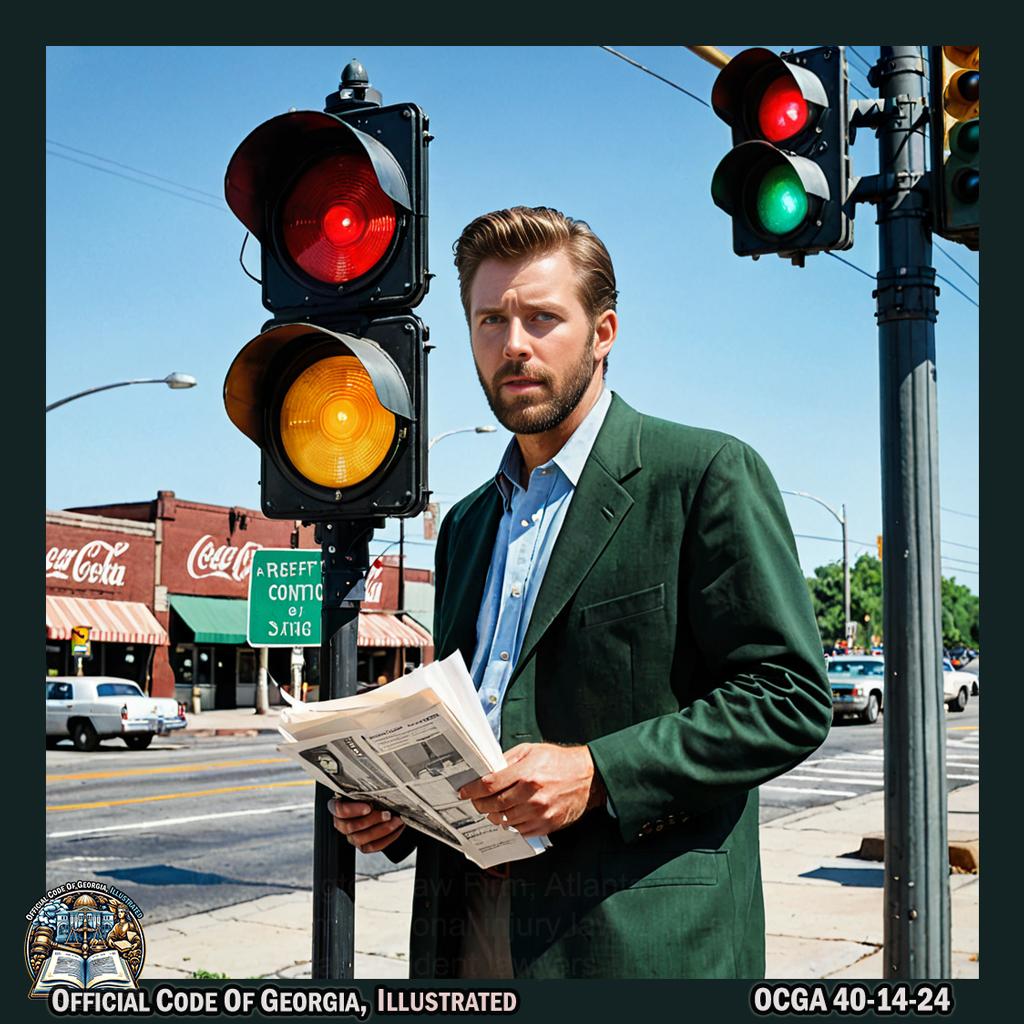
Charles Kelley stands in front of a traffic light, holding a stack of papers representing the report. He then hands over any revenue generated from the traffic control signal monitoring device to an actor representing the general fund of the state, while gesturing towards an actor symbolizing the Department of Transportation. This art piece is captured in Vivian Maier's signature candid style against a backdrop inspired by the World of Coca-Cola. -@charleskelleyla -
The Department of Transportation shall forward copies of all reports to the offices of the Governor, Lieutenant Governor, and the Speaker of the House by March 1 of each year. The department shall also forward to the offices of the Governor, Lieutenant Governor, and the Speaker of the House a complete list of all traffic-control signal monitoring devices currently in use.
40-14-25.Complaints about traffic-control signal monitoring devices; rebuttable presumption; remission of revenues.¶
- Complaints surrounding the use and operation of traffic-control signal monitoring devices by governing authorities, including the use by a governing authority for any purpose other than the promotion of the public health, welfare, and safety or in a manner which violates this article or violates its operating permit, may be made to the commissioner of transportation. The commissioner or the commissioner’s designee is authorized to conduct an investigation into the acts and practices of the governing authority with respect to the use of traffic-control signal monitoring devices. If, as a result of this investigation, there is evidence to substantiate a violation of this article or the rules and regulations of the Department of Transportation, the department may take any action deemed necessary to prevent further misconduct or violations, including denying an application for a permit or suspension or revocation of a permit.
- There shall be a rebuttable presumption that a governing authority is using traffic-control signal monitoring devices for purposes other than the promotion of the public health, welfare, and safety if such devices are used by a governing authority without a valid permit issued by the Department of Transportation or in violation of any requirement of this article or the rules and regulations of the department.
- Where a violation of this article by a governing authority or any law enforcement agency enforcing the use of traffic-control signal monitoring devices on behalf of such governing authority is substantiated, the Department of Transportation may order that revenues generated from the use of traffic-control signal monitoring devices during the time of such violation or misconduct shall be remitted to the state’s general fund. The department’s order to remit funds shall be a continuous order until the violation is corrected by the governing authority as determined by the department. Any governing authority failing to abide by such order shall be liable for interest and costs, including reasonable attorney fees, incurred in the enforcement of the order. Jurisdiction for enforcing the department’s order shall be in the Superior Court of Fulton County.
40-14-26.Revoking traffic-control signal monitoring device permit; hearing; reconsideration.¶
- Upon issuance by the commissioner of transportation of an order denying an application for or suspending or revoking a traffic-control signal monitoring device permit, the governing authority affected shall be afforded a hearing, to be held within 30 days of the effective date of the order. The hearing shall be held before the commissioner of the department or his or her designee, and, within 30 days following the hearing, the governing authority affected shall be served with a written decision announcing whether the permit shall remain denied, suspended, or revoked or whether it shall be granted or reinstated.
- Only after the expiration of three years following the revocation of a traffic-control signal monitoring device permit shall the governing authority make application, upon a change of circumstances being shown, to the commissioner of transportation for a reconsideration of whether the governing authority should be permitted to use traffic-control signal monitoring devices.